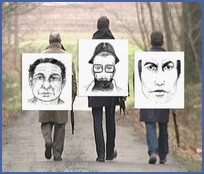|
| | Morlion, Félix |  |
| | |
| Auteur | Message |
|---|
HERVE
Nombre de messages : 21559
Date d'inscription : 08/12/2009
 |  Sujet: Morlion, Félix Sujet: Morlion, Félix  Sam 18 Juil 2015 - 13:24 Sam 18 Juil 2015 - 13:24 | |
|
Félix Morlion était un père dominicain, anticommuniste convaincu très actif dans la région d'Anvers avant la seconde guerre mondiale.
Par après il a principalement vécu aux Etats-Unis et à Rome.
Il a été à l'origine de "Pro Deo" (mgr Carlo Ferrero lui a succédé)
_ _ _
http://www.luiss.edu/university/history
LUISS Guido Carli has its origins in an earlier Roman institution: Pro Deo University, founded in 1966.
In 1974 a group of entrepreneurs led by Umberto Agnelli decided to invest human and financial resources in an innovative educational project aimed at executives.
(...)
In 1977, the University officially changed its name to LUISS— Libera Università Internazionale degli Studi Sociali, or the Guido Carli Free International University for Social Studies. A year later, Guido Carli, who was then President of the Italian industrial association, Confindustria, became the University’s President.
_ _ _ _ _ _ _ _ _ _
Il est aussi question de F. Morlion et de "Pro Deo" dans le très intéressant article suivant (en italien) :
http://web.mclink.it/MJ4596/pro%20deo.htm
Articolo - inchiesta ProDeo
_ _ _ _ _ _ _ _ _ _
In a 1994 deposition Francesco Pazienza says he was introduced to Roberto Calvi for the first time by two Chase Manhattan officials, Dominic Scaglione and Rodolfo Rinaldi, who in their turn had been introduced to him by Mgr Ferrero, president of Pro Deo at the time.
http://www.luiss.edu/university/history
"Chase Manhattan", cela fait penser à David Rockefeller...
Voir :
https://fr.scribd.com/doc/241043341/DNSA-00334-Kissinger-Violet
_ _ _ _ _ _ _ _ _ _
http://www.comayala.es/Libros/ddc2i/ddc2e17.htm
( ... ) In April of 1979, Padua Judge Pietro Calogero took testimonies that implicated in subversive activity leaders of the Hyperion Institute, a “language school” founded in Paris in 1974 by Corrado Simioni, Giovanni Mulinaris, Duccio Berio, Franco Troiano, Françoise Tuscher and Innocente Salvoni. The directors of the school had obtained the approval of the French secret police and enjoyed the support of the Dominican Felix Andrew Morlion, founder of the Vatican secret service Pro Deo and CIA agent. The Hyperion Institute has (or had) its center in Paris [80] . ( ... )
[80] In Quai de la Tournelle, 27.
_ _ _ _ _ _ _ _ _ _
http://lombardia.indymedia.org/node/31213
( ... )
Notamment un commentaire :
Inserito da Anonimo il Gio, 19/08/2010 - 11:47
L'Unico L'individualista
Abbè Pierre, il cappuccino, il partigiano, il fondatore di Emmaus, il frate. La sua ineffabile figura si staglia sullo sfondo di alcuni fra i più cupi misteri del dopoguerra italiano, il terrorismo, la nascita delle BR, l'affaire Moro.
Abbè Pierre era lo zio di Françoise Tuscher, moglie di Innocente Salvoni, fra i fondatori nel 1970 dell'ambiguo "Superclan", cellula di superclandestini, tutti a vario titolo collegati ai servizi segreti italiani. Sei anni dopo, Salvoni col nucleo del superclan a metà fra terrorismo e spionismo, Corrado Simioni, Vanni Mulinaris, Duccio Berio, Franco Troiano e la stessa Tuscher, fondano a Parigi una enigmatica “scuola di lingue” chiamata Agorà, poi Hyperion: benchè quasi tutti siano interessati da indagini sull'eversione, questi dirigenti del Superclan ottengono il beneplacito dei Servizi Francesi per varare l'istituto Hyperion; godono pure dell'appoggio del padre domenicano Felix Morlion, l'uomo della Cia in Vaticano, fondatore del servizio segreto Pro Deo, nel raggio di interesse del Venerabile Gelli (il quale raccoglie su di lui un intero dossier) e del quale il giovane Giulio Andreotti è segretario particolare nel primissimo dopoguerra.
Indirizzo e numero di telefono di padre Morlion verranno trovati nel materiale sequestrato ai brigatisti Valerio Morucci e Adriana Faranda, due fra i più autorevoli luogotenenti di Mario Moretti, contestualmente al loro arresto il 29 maggio 1979. Nella ragnatela Pro Deo finirà risucchiato anche l'ex gerarca nazista Karl Hass, il responsabile dell'eccidio delle Fosse Ardeatine, reclutato nel 1947 mentre a Fermo, nelle Marche, riparato sotto falso nome nel collegio “Sacro Cuore”, insegna inglese e matematica. L'Hyperion, già Agorà, ha sede a Parigi in quai de la Tournelle, 27: anni dopo, le inchieste della magistratura e delle commissioni parlamentari Stragi e Moro, confermeranno che l'enigmatico istituto di lingue altro non è che una camera di compensazione dei servizi segreti di Yalta: oltre alla Cia, che ne regge le fila, ad essa fanno capo i servizi tedeschi, inglesi, italiani e ovviamente francesi.
Il gruppo superclandestino gode inoltre della protezione dell'Abbè Pierre, eroe della Resistenza francese, ex parlamentare e membro della Commissione Difesa. Legato ai Servizi e all'alta politica, al punto che lo stesso Salvoni, suo nipote acquisito, arriverà a vantarsi di “arrivare al presidente Giascard d'Estaing” in caso di bisogno. Alcuni brigatisti pentiti riferiranno che l'Hyperion gestiva le relazioni internazionali delle BR, tenendo contatti con i servizi segreti dell' Ira, l'Eta, la Raf, l'Olp e garantendo i canali di approvvigionamento di armi e denaro. All'inizio del 1978, pochissime settimane prima della clamorosa operazione brigatista di via Fani, l'Hyperion apre una sua sede strategica a Roma, in via Nicotera, 26, in un edificio costellato di società di copertura del Sismi, oltre ad una “filiale” a Milano.
Quindi, il 16 marzo, a pochi minuti dall'eccidio, il Viminale diffonde, tra le foto dei terroristi sospettati, anche quella di Salvoni, membro dell'Hyperion (frequentata peraltro, si saprà poi, anche dal capo BR Moretti e perfino da Anna laura Braghetti, la carceriera di Moro, unica col boss a tenere i contatti a Parigi con la fonte coperta “Luis”, al secolo Jean-Louis Baudet, esperto di missili e attivo nel Crise, centro di ricerche e investigazioni socioeconomiche francese. Baudet verrà poi arrestato poco dopo l'arresto di Moretti nel 1981, al che emergerà il suo contatto con la “cellula” dell'Eliseo, struttura direttamente dipendente dalla presidenza della Repubblica francese). A quel punto, l'Abbè Pierre si spende personalmente, recandosi alla sede DC di piazza del Gesù a Roma; immediatamente, il colonnello del carabinieri Antonio Cornacchia (affiliato alla P2) sviluppa un'opera di depistaggio, dichiarando “infondate” le segnalazioni a carico di Salvoni, la cui foto scompare da quelle dei ricercati.
In giugno, un mese dopo l'uccisione di Moro, la sede romana dell'Hyperion comincia a sbaraccare, come un presidio ormai divenuto inutile: chiuderà definitivamente i battenti nel successivo ottobre (quando gli uomini del generale Dalla Chiesa hanno appena inflitto un colpo risolutivo alle BR scoperchiando il covo milanese di via Monte Nevoso, con la cattura di nove brigatisti di primissimo piano e il rinvenimento parziale del memoriale Moro). Contemporaneamente alla sede romana, viene dismessa anche filiale meneghina.
La sede romana di via Nicotera aveva assunto la parvenza di una agenzia di viaggi per studenti italiani in Francia o francesi in Italia per il perfezionamento delle lingue, una coincidenza d'intenti significativa con la Casa Madre parigina. Altri retroscena, coincidenze sospette e segreti irriferibili si agiteranno intorno alla Hyperion, ai suoi protagonisti, ai suoi burattinai: se ne occuperà a più riprese la magistratura, anche a distanza di tempo: come nel 1979, quando il giudice padovano Pietro Calogero raccoglie alcune testimonianze che coinvolgono nell'attività eversiva italiana i vertici dell'Hyperion. Nemmeno un anno dopo, sarà il segretario Psi Bettino Craxi ad alludere a un fantomatico Grande Vecchio brigatista “tra quei personaggi che avevano cominciato a fare politica con noi e poi sono scomparsi, magari sono a Parigi a lavorare per il partito armato”
come Corrado Simioni, il braccio destro di Coprrado Corchi proveniente dalle file di alleanza cattolica. Anche il giudice Priore s'imbatterà nel muro di segreti e reticenze dell'Hyperion, ricordando tra le altre l'inchiesta sulla strage di Ustica. In particolare, il solito Abbè Pierre riesce ad insabbiare indagini che coinvolgono Senzani e i vecchi fondatori del Superclan, nonché dell'Hyperion, in relazione ad un traffico d'armi internazionale. Ma il livello di protezione della falsa scuola di lingue non si abbassa neppure nel 1983, quando la Francia continua ad opporre un muro di silenzio alla Commissione parlamentare d'inchiesta Moro.
Nel novembre del 1992, Corrado Simioni, impunito e ormai blindato, verrà ricevuto in udienza privata da papa Giovanni Paolo II, accompagnando l'Abbè Pierre.
Come il don Giussani di Comunione & Liberazione, come altri guru dei nostri tempi, questo Abbè Pierre fu più santone che santo: compromesso con la più fosca e inquietante mondanità, che, più di mondare, occultava e proteggeva.
E’ un dato assodato, ad esempio, la continuità tra l’Ovra – la polizia segreta fascista – e l’Ufficio Affari riservati di Umberto D'Amato sul piano del personale e delle modalità organizzative: segno evidente della “riconversione” repubblicana – nel nome dell’anticomunismo e sotto l’attenta regia dei servizi segreti americani - di agenti fino a poco prima convinti e spietati servitori del fascismo e della RSI. E’ a partire dalla seconda metà degli anni ’60 che avanza e s’impone Federico Umberto D’Amato, una delle figure più ambigue, difficilmente decifrabili e sfaccettate dei servizi segreti italiani. Uomo di fiducia del governo americano, ex repubblichino. L’Ufficio Affari Riservati cessò di esistere nel 1974, poco dopo la strage di Piazza della Loggia. Stava cambiando la fase politica a livello internazionale e stavano venendo meno alcuni presupposti della strategia della tensione: perciò lo Stato cominciò a smantellare gli apparati maggiormente collusi, riverniciandoli di nuovo, nascondendo la cenere sotto il tappeto e scaricando le figure più compromesse. D’Amato se la cavò, venne mandato a fare il capo del servizio di polizia di frontiera e continuò a giocare il proprio ruolo fino alla fine con ambiguità, arroganza e sfrontatezza. Molti fra i componenti di entrambi i comitati sarebbero in seguito risultati iscritti alla P2; ne faceva parte lo stesso Licio Gelli sotto il falso nome di ingegner Luciani. Nel 1966, quando entrò per la prima volta al governo, Cossiga ricevette la delega, come Sottosegretario alla Difesa, a sovrintendere Gladio, sezione italiana di Stay Behind, organizzazione segreta dell'Alleanza Atlantica, di cui facevano parte anche Austria e Svezia.
Giovane allievo di Antonio Segni, ondeggiò tra Carlo Fumagalli, ( partigiano Bianco capo antifascista dei Nar) Taviani e Moro prima di manifestarsi provvisorio doroteo di complemento. Cossiga mentore “anticomunista” della fazione pro-angloamericana “bianca” di Taviani e dello Stay Behind.
L'ufficio di D'Amato si occupava di operazioni sporche, depistaggi, di infiltrazioni nella sinistra estrema e non, e collaborava con la destra, con cui aveva rapporti privilegiati. La struttura retta da D'Amato fu sciolta nel 1974 a causa del suo coinvolgimento sulla strage di Brescia, ma il nostro volenteroso servitore dello stato continuò a svolgere il suo lavoro in maniera più riservata di quanto abbia mai fatto precedentemente.......Iscritto alla P2, strettamente legato alla CIA, divenne membro del comitato di crisi parallelo costituito presso il ministero della marina militare nei giorni del sequestro Moro, insieme a Licio Gelli e Steve Pieczenik, braccio destro di Kissinger. Continuò a mettere a disposizione degli apparati statali la sua enorme esperienza, diventando nei fatti il consigliere del ministro dell'interno Cossiga nei giorni dell'emergenza Moro.
Cultura dal basso contro i poteri forti
_ _ _ _ _ _ _ _ _ _
Eurologos
Son fondateur-directeur, M. Troiano, Milanais, possède un passé en tout point semblable à ceux de ses collègues parisiens Berio et Simioni. Il vient de la gauche « extra-parlementaire », plus précisément du groupe Sinistra Proletaria et fut, à la fin des années 60, membre du groupe terroriste GAP (Groupe prolétaire armé), animé en Italie par Giangiacomo Feltrinelli, d'extrême gauche, en particulier de l'aile favorable à la guérilla.
Cet éditeur italien né à Milan en 1926, riche héritier devenu communiste, est retrouvé mort à côté d'un pylône en mars 1972, après un attentat.
Après la mort de Feltrinelli, on n'entendra pratiquement plus parler des GAP. Une partie des troupes rejoindra le mouvement d'extrême gauche Pouvoir ouvrier — c'est un retour aux sources; une autre se fondra dans les Brigades rouges.
Extraits de
Affaires d'État: des dossiers très spéciaux, 1981-1987
Henry Allainmat, Gilbert Lecavelier - 1987 - 319 pages
Hyperion envoie des «petites colonnes» au Liban et dans d'autres pays pour y subir un entraînement militaire et se former à la guérilla urbaine. Une quarantaine de Français et d'Italiens ont été arrêtés dans un camp d' entraînement ( ... ) Hyperion « gère » un réseau d'abris sur le territoire français où les terroristes viennent se mettre au vert après un « coup ». Hyperion est un point de rencontre entre diverses organisations terroristes européennes.
_ _ _
http://fncrsi.altervista.org/sinistra_nella_strategia_tensione.htm
La sinistra antagonista nella strategia della tensione
Il est aussi sur :
http://www.jerusalem-holy-land.org/Sinistra_Antagonista_Strategia_Tensione.pdf
( ... )
Dans OP (Observatoire politique), 18.2.1977, Mino Pecorelli, journaliste à entrature dans notre "intelligence" ("servizi segreti"), nous avons rapporté le contenu d'un document de la SDECE (service secret français) sur la "stratégie de la tension" et l'implication du Mossad, le service secret israélien.
( ... )
Surtout Aldo Moro (ministre des Affaires étrangères ou le Premier ministre), liés aux domaines de la Curie, a été particulièrement détesté par l'Atlantique pour son ouverture politique à la carte PCI et son équidistance prudent dans le conflit israélo-arabe, est également favorable à la réalisation des accords avec les Palestiniens pour empêcher notre pays est devenu une sanglante no man's land dans la bataille sans merci entre le Mossad israélien et le désespoir des Palestiniens.
( ... )
Mais il est dans les affaires des Brigades rouges qu'il ya eu de nombreux indices de "contamination" de l'organisation et l'exploitation par le Mossad israélien.
( ... )
Curieusement, à cette occasion, l'autre, historien en chef Mario Moretti a toujours été en faveur d'un virage militariste solides, bien que déjà identifiés et photographiés par la police, miraculeusement échappé à l'arrestation et a hérité de la Brigades propriété.
( ... )
Mais surtout, ne pas expliquer l'absurde et incroyable comportement absolument de BR dans l'enlèvement de Moro. ( ... ) a parlé et a dit tout et plus encore, et tuez-le, contre l'avis de plusieurs couches de-gauche extra parlementaire et de l'autonomie, sachant fort bien que les Américains veulent sa mort, les Israéliens le considèrent comme de la poudre aux yeux et une grande partie du même Parti démocrate chrétien a laissé entendre à ne pas accepter le retour de l'arène politique, mais surtout ils se cachent et disparaissent, plus à l'enlèvement de Moro en cours, tous les «aveux», important Moro et dévastatrice avait fait à ses ravisseurs. ( ... ) surtout, avait confié les secrets d'État sensibles sur la structure du Gladio !
Mais peu, presque rien de tout cela a été rendu public et le procès-verbal de l'interrogatoire avec les bobines ont été faites à disparaître, de sorte qu'une partie est restée inconnue.
( ... )
En 1974, Simioni et ses compagnons ont disparu de l'Italie et a créé en France, à Paris, une école de langues, "Agora", puis nomata "Hyperion", désormais considérée comme une centrale illégale (couvert par les services français et il semble même le Vatican Secret Service Pro Deo dont le fondateur, Morlion père travaillait pour la CIA). On pense que le "Hyperion" a été un point de croisement des différents services internationaux, voire opposés, mais tous engagés à inspirer des actes de terrorisme en Europe qui, en fait, derrière une spontanéité de la peinture, anarchistes ou de gauche, ils sont retournés à l'avantage de maintenir le statu quo de Yalta.
( ... )
«Duccio Berio avait le bras droit de Simioni, son père était un célèbre médecin Juif Milan à lui lié à l'intelligence israélienne. Berio, entre autres, était aussi le fils d'Albert Malagugini membre dirigeant de l'ancien PCI. ( ... ) Mais un autre médecin à Milan, à côté de la BR et dont le nom n'a pas été fait, a été soupçonné de collusion avec le Mossad.
( ... )
Comme l'a déclaré le sénateur Flamigni "la conclusion de la scène du crime que Moro était le ghetto juif, et est donc un certain intérêt l'histoire de la tanière des Brigades rouges dans le ghetto juif de Rome, ce domaine topographique, plein de donjons, magasins et dépôts de divers types, où rien ne peut se faire sans sortir de la communauté juive qui vivent ou travaillent, et on suppose, sans l'approbation ou la connaissance des services de renseignement israéliens
( ... )
Nous ne savons pas si un jour l'histoire sanglante des "années de plomb" sera enfin révélé dans son intégralité, mais il est certain que s'ils le faisaient, ce jour-là il y aura de nombreuses surprises et beaucoup seront surpris quand on sait que "droite" et " côtés gauche ne sont pas aussi extrêmes "en face" comme on le pensait, parce que "même main" dans les coulisses les manœuvres.
_ _ _ _ _ _ _ _ _ _
Pour information, on retrouve le dominicain belge Félix Morion dans un ancien article :
http://www.time.com/time/magazine/article/0,9171,799920-2,00.html
ITALY: How to Fight Communists
Monday, Mar. 28, 1949
Catholic Action speakers frequently engage Communist leaders in public debates. One of the most tireless debaters is a Dominican, Father Felix Morlion, who challenged Red Boss Palmiro Togliatti to a debate over Cardinal Mindszenty's trial. Togliatti sent a substitute, Communist Senator Ottavio Pastore. When Pastore was through, Father Morlion quietly mounted the rostrum beneath a huge portrait of Togliatti and smilingly proceeded to answer the Senator's ranting. "To conquer misery," Father Morlion concluded, "it is not necessary to suppress religion."
_ _ _
Un autre document intéressant :
http://poteriocculti.mastertopforum.biz/-vp20067.html
Note : "Pro Deo" est devenu une université privée qui a soulevé l'intérêt de nombreux industriels italiens et est maintenant la LUISS (Université Libre Internationale des Sciences Sociales).
DOCUMENTO 1
UN PERSONAGGIO DA CONOSCERE: PADRE FELIX MORLION.
( ... )
Ma chi era Felix Morlion? Una breve ricerca in internet permette di capire che è un personaggio di indubbio spessore.
Morlion giunse negli USA dopo l’arrivo dei tedeschi nella sua patria, il Belgio, dove era ben noto, essendo stato tra i fondatori dei centri cinematografici cattolici belgi; fu anche, leggiamo nel sito socialistregister.com, uno dei componenti del COPAC (Centro di propaganda anti comunista fondato dal visconte Charles Terlinden), che aderì ai CAUR (Comitati d’Azione per l’universalità di Roma) collegandosi in tal modo economicamente e politicamente con il fascismo italiano. Il COPAC lavorava inoltre a stretto contatto con un’altra associazione belga, la SEPES (Società di studi politici, economici e sociali, teniamo a mente questa denominazione, n.d.r.), una specie di servizio segreto di propaganda e “intelligence” anticomunista fondata nel 1925, che negli anni ‘30 lavorò in stretto contatto con il governo tedesco. Nel sito prima citato troviamo anche uno studio di Rudi van Doorslaar sull’attivismo anticomunista in Belgio dal 1930 al 1940, dove leggiamo che le attività del COPAC erano direttamente collegate a quelle della SEPES e che lo stesso Morlion dirigeva le “shock brigades”, paragonabili agli “squadristi” italiani.
Il risultato concreto di queste attività fu che, quando i nazisti ebbero invaso il Belgio, il materiale raccolto dai due gruppi portò all’arresto ed alla deportazione di molti comunisti locali e di rifugiati tedeschi che avevano trovato riparo soprattutto ad Anversa.
( ... )
Nel 1968, a Roma usciva un giornale, il “Mondo illustrato”, sul quale scriveva Mino Pecorelli, che pare vi avesse anche investito di suo. Questo giornale pubblicò la foto di Morlion a fianco di Andreotti in un articolo in cui si anticipavano, per il numero successivo, rivelazioni relative a soldi, sesso, servizi, affari loschi all’ombra del Vaticano. Ma il numero successivo non vedrà mai la luce. Si insinua che Pecorelli avesse ricevuto una notevole somma per cessare le pubblicazioni e “sparire” per un po’ dalla circolazione, ma non smise di scrivere e, tempo dopo, dopo aver nuovamente promesso rivelazioni spettacolari su Moro, Andreotti e altre realtà democristiane, fu ucciso da persone ancora oggi avvolte nel mistero con un’arma particolare che utilizza proiettili di tipo speciale, in dotazione esclusiva pare delle forze speciali della NATO.
Il nome di padre Morlion appare anche nelle inchieste sulla scuola Hyperion di Parigi, quella che per lungo tempo era stata sospettata di essere il centro direttivo delle Brigate Rosse e che ebbe anche, per pochissimo tempo all’epoca del sequestro Moro, una sede a Roma. Sembra che Morlion avesse intercesso presso il governo francese che poneva difficoltà ad autorizzare l’apertura della scuola in quanto gli insegnanti erano per la maggior parte “rifugiati politici” inseguiti in Italia da mandati di cattura.
Altre tracce di Morlion si trovano poi nella vicenda dell’attentato di Alì Agca a papa Woityla. L’attentatore infatti disse che l’ordine di agire gli fu dato a Roma in appartamento di via Pola 12 (residenza di un certo Antonov, addetto all’ambasciata di Bulgaria) che descrisse nei particolari, disegnandone, pare, anche una piantina dettagliata. Solo un particolare non corrisponde: una porta, che Agca descrisse come scorrevole, a scomparsa nel muro, risultò invece essere normale. Il lato curioso di questa “confusione” è che la descrizione di Agca corrisponde invece perfettamente all’appartamento sottostante che è uno degli appartamenti di proprietà dell’università Pro Deo, in uso a Morlion. Chi fece queste rivelazioni, in sede di commissione Mitrokhin, fu Giulio Andreotti, che citò a testimone il senatore Consolo che gli aveva parlato della vicenda della piantina. Il tutto finì con una battuta di spirito e sembra che nessuno abbia inteso aprire un’inchiesta su questa strana combinazione.
Di Morlion parla anche Gaia Cenciarelli nel suo libro sulla scomparsa di Emanuela Orlandi (“Extra Omnes, l’infinita scomparsa di Emanuela Orlandi”, ed. Zona).
Nel “Covert action information bulletin”, pubblicazione fondata dall’ex agente CIA Philip Agee, reperibile in vari siti internet, vi sono dei riferimenti che collegano Morlion al Sovrano Militare Ordine di Malta (SMOM), relativamente a finanziamenti e onorificenze conferiti prima della guerra ad ambienti filonazisti, e nel dopoguerra a nazisti “riciclati”, come Reinhard Gehlen, passato dai servizi nazisti ai servizi USA prima e tedesco occidentali poi.
Infine, Morlion appare tra i fondatori del Center For Economic And Social Justice (CESJ) che annovera numerosi alti prelati, componenti della finanza internazionale e varie personalità di spicco, aventi in comune idee conservatrici e l’essere favorevoli al libero mercato.
Padre Morlion, servitore discreto di 5 papi ed attivo in molti campi non sempre ecclesiastici, morì nel 1987. Ebbe parte attiva, come abbiamo visto, in gran parte della storia dell’Italia repubblicana, ma manca una biografia che metta in luce un personaggio così importante.
_ _ _ _ _ _ _ _ _
Il libro che i servizi segreti italiani non ti farebbero mai leggere
Gianni Flamini
Editore
Newton Compton
Collana
Controcorrente
Data uscita
24/06/2010
Pagine
288, brossura
Lingua
Italiano
EAN
9788854116245
Quella che viene raccontata in questo libro è una storia che si snoda lungo un sessantennio di vita dei Servizi segreti repubblicani, sia militari che civili. Un'indagine che ripercorre ed esamina le vicende incrociate di sei personaggi: Licio Gelli, Federico D'Amato, Guido Giannettini, Luigi Cavallo, il frate domenicano Felix Morlion e lo storico, politologo e giornalista americano Michael Ledeen. Sullo sfondo di tutti i casi che il libro prende in considerazione, si puo rintracciare il costante e impunito ricorso alle schedature di massa e al segreto di Stato come ultima (e attualissima) ancora di salvezza. Un viaggio attraverso le fondamentali vicende di cui i Servizi sono stati promotori, protagonisti, testimoni. Ma anche uno spaccato dei lati oscuri, del loro senso d'onnipotenza, dei fallimenti e delle colpe.
From: info@archivioflamigni.org
Subject: R: Hyperion, Eurologos, Franco Troiano, Felix Morlion
Date: Thu, 6 Jan 2011 15:57:21 +0100
Hello,
the Archive does have documents about Hyperion; I have quoted some of them in my books “La Tela del ragno” and “La sfinge delle Brigate rosse”, both published by Kaos Edizioni. In the name index of this last book you will also find Franco Troiano and Felix Morlion, about whom I have written also in my books “Il mio sangue ricadrà su di loro” and “Le idi di marzo”, published by Kaos. Also Gianni Flamini writes about Morlion in his recent “Il libro che I servizi segreti italiani non ti farebbero mai leggere”, published by Newton Compton. We have nothing on Eurologos.
Regards,
Sergio Flamigni
_ _ _ _ _ _ _ _ _ _ _
From 1932 until 1938 Myron Charles Taylor was the Chairman of U. S.
Steel. In 1939 he became the U.S. envoy to Pope Pius XII, a post he
would maintain until 1950. Meanwhile, according to Anthony Cave Brown,
OSS chief William Donovan secretly had established an intelligence
connection with the Vatican as early as 1941, when he evacuated from
Lisbon to New York the Dominican Father Felix A. Morlion, who had
founded "a European Catholic anti-Comintern'' called Pro Deo. (See
sidebar.) Throughout the war Donovan financcd Morlion's Pro Deo service
and in June 1944 he "went to considerable expense, time, and trouble to
transport Morlion from New York and establish him at the Holy See.''8
Subsequently Morlion became a key figure in Vatican intelligence,
working closely with Giovanni Battista Montini, the future Paul VI.
According to Frederic Laurent,
"All studies [of the post-WWII Nazi networks] have shown the determining
role played by the Catholic Church in the flight of war criminals. Since
April 1943, following negotiations between Pius XII and the
ultra-reactionary American archbishop Francis Spellman, the Holy See
became the clandestine center of Anglo-American espionage in Italy. This
collaboration in fact had begun the previous year ...... between Earl
Brennan, a veteran of the American State Department and Gian Battista
Montini, at the time a bishop and Under-Secretary of State at the
Vatican. This close collaboration between the future Paul VI and the
Ameriean secret services continued after the war through the
intermediary James Angleton. ..... 9"
(...)
_ _ _ _ _ _ _ _ _ _
Voir aussi ce qui concerne un autre père dominicain :Yves-Marc Dubois ... proche de Jean Violet ("avions renifleurs")
(il faut se souvenir que la "Milice de Jésus-Chrsit" est liée aux dominicains...)
http://www.8bitmode.com/rogerdog/lobster/lobster26.pdf
Extrait :
(...)
An early associate of Violet's in his work for the SDECE was fellow agent
Father Yves-Marc Dubois, foreign policy "spokesman" for the Dominican order,
unofficial member of the Pontifical Delegation to the UN, and believed by the
SDECE to be the head of the vatican secret service. The pair were active in the United
Nations in the mid50s, to prevent UN condemnation of France's Algerian policy,
when Violet was attached to the French delegation headed by Antoine Pinay.
Another major focus for Violet and Dubois' activities for the SDECE was Eastern
Europe: they received half a million francs a month from General Grossin to run "the
Church of Silence", Catholic networks behind the Iron Curtain.'
(...)
_ _ _ _ _ _ _ _ _ _
http://www.mosquitonet.com/~prewett/caqsmom25.2.html
The Role of Felix A. Morlion
In the latter part of April 1948 the Romanian Timpul published an article, "The Vatican Espionage Service," cited in the Soviet journal New Times, No.31, 1948, at pp. 5, 6. As reported, the article indicated that,
"In 1946 the Pope entrusted the Dominican friar [Felix A.] Morlion, a Belgian, with the reorganization of the Vatican intelligence service and its merger with the jesuit espionage network. The central intelligence department of the Vatican is headed by Janssens, a general of the Jesuit Order. His deputy is Montini, the acting Vatican Secretary of State, and his assistants are Schmider, the administrative director of the central jesuit espionage bureau, and Morlion, director of Centro d'informazione pro Deo. The central intelligence department is subdivided into branches and sections dealing with the various countries. One of the main branches is the so-called 'special division' which operates under the signboard of the Centro d'informazione pro Deo press agency. Similar divisions have been set up in the Centro d'informazione pro Deo units in all parts of the world. In New York the 'special division' is directed by Cardinal Spellman, in Innsbruck (Austria) by Regent, the rector of a jesuit college, in Coblenz (Germany) by the Catholic priest Poelaert who is also director of the Catholic press agency. The branch in charge of espionage in Eastern and Southeastern Europe is supervised by Schmider and Preseren, the jesuits' chief expert on the Slav countries and adviser to the Vatican Secretary of State."
In August 1966, Morlion approached H. L. Hunt for funding Vatican anti-Communist operations in Latin America. Hunt gave an interview to the British Guardian Weekly, February 27, 1969:
" 'I was approached by Paolo Cardinal Marella, who said he spoke for the Pope and asked if I would supply members of my [20,000 member] Youth Freedom Speakers' movement who spoke Spanish to be sent south [to Latin America] to engage in speechmaking and activities. I was told the Pope was thinking in terms of 11 million dollars a year support for the entire movement against communism in Spanish-speaking countries.' ......... The project was now centered in New York, at the Asian Speakers Bureau, with the Free Pacific Association, Inc., on Riverside Drive [another front for the Rev. Moon's Unification Church]. A key figure in this papal concern over Leftist threats to the Vatican's greatest stronghold was thc Rev. Felix A. Morlion, who was present at the original discussions. "
Subsequently, Morlion emerged as a key figure in the "Bulgarian Connection" hoax when the fascist Grey Wolf Agca attempted to assassinate the Pope: It appears that Morlion lived in Rome directly below the apartment of the Bulgarian Antonov, and was a possible source of Agca's description of Antonov's apartment. (See, Il Mondo, April 8, 1985; L'Espresso, May 19, 1985.)
_ _ _ _ _ _ _ _ _ _
Il est question de Félix Morlion sur :
http://www.journalbelgianhistory.be/en
http://www.google.be/url?sa=t&rct=j&q=&esrc=s&source=web&cd=3&ved=0CFYQFjAC&url=http%3A%2F%2Fwww.journalbelgianhistory.be%2Fnl%2Fsystem%2Ffiles%2Farticle_pdf%2FBTNG-RBHC%2C%252017%2C%25201986%2C%25201-2%2C%2520pp%2520227-267.pdf&ei=IBYLUMGGJYqy0QXlwomxCg&usg=AFQjCNF_d3DPnTtcU2Sns2FsTY-AnvUrQw&sig2=fvYA7lxjP9SSujUleapQiQ
BTNG-RBHC, XVII, 1986,1-2, pp. 227-268
DE OFFENSIEFBEWEGING IN VLAANDEREN 1933-1939 :
KATOLIEKEN TUSSEN TRADITIE EN VOORUITGANG (*)
door Lieve DHAENE
Licentiate Geschiedenis K.U.L.
(...)
De term Offensiefbeweging werd gebruikt als een overkoepelende benaming voor een aantal initiatieven inzake katolieke apostolaatsarbeid en propaganda die voor het grootste deel gestalte kregen en geleid werden vanuit het Antwerpse dominikanerklooster, vooral onder impuls en koördinatie van pater Felix Morlion.
(...)
_ _ _ _ _ _ _ _ _ _ _
Extrait de
LA DROITE BELGE ET L'AIDE A FRANCO
par Francis BALACE
(...)
Le Père Morlion, vigoureux prédicateur de cette nouvelle croisade, "spécule sur la curiosité de la masse flottante, la plus exposée à la propagande communiste. La plupart des hommes se laissent aisément conduire par leur imagination et leurs sentiments.
Il faut donc créer une imagination et un sentiment anti-communiste.
C'est à dessein qu'ainsi la première affiche donne dans le genre macabre. Une église en feu, des cadavres mutilés, des ruines, le tout associé à l'idée du communisme (48)".
(48) "Rapport de la Réunion anti-communiste tenue à Liège le jeudi 18
mars 1937", dactylographié (Séminaire d'Histoire Contemporaine, Universi-
té de Liège). Etaient présents plusieurs chefs d'entreprise d'opinion catholi-
que : Henri et Paul Doat (Cie Générale des Conduites d'Eau), Francken (Es-
pérance-Longdoz), Houbaer (Cockerill), Paquot (charbonnages Espérance-
Bonne Fortune), Léonard (Angleur-Athus), Timmermans {Ateliers de la
Meuse), Goffart (charbonnages du Gosson), de Spirlet (chemins de fer du
Nord-Belge), de Lannoy (Banque de Bruxelles), le Baron van Zuylen et Sad-
zot. Parmi les excusés le Sénateurs Hanquet et les dirigeants de Phénix-
Works, Englebert, Tubes de la Meuse, Vieille Montagne, charbonnages de
Wérister, etc...
La guerre d'Espagne est pour le Père Félix-André Morlion un thème essentiel de propagande anti-communiste dans les colonnes de sa feuille bi-hebdomadaire De Waarheid, tirant à 20.000 exemplaires, éditée par les Dominicains de la Ploegstraat d'Anvers et diffusée dans les villages des Flandres par les soins de la Katholiek Perscentrale et des Offensief-Brigades fondées en 1933 pour combattre, au besoin à coups de poing, l'immoralité des spectacles (49).
Abondamment illustrée, dotée de gros titres en rouge, utilisant un langage populaire, De Waarheid publiera des numéros spéciaux sur la "croisade" d'Espagne (50), louant Franco mais préférant dans son camp les "démocrates" de YAccion Popular et de Renovacion Espanola aux "totalitaires" de la Phalange et des Requêtes (51). Le Père Morlion et ses confrères utilisent le cas espagnol pour combattre le communisme en Belgique (52), et plus particulièrement en Flandre, mais leurs appels aux jeunes catholiques pour qu'ils soient, si besoin était, prêts à combattre, "à avoir le courage de se battre pour défendre la religion (53)" resteront purement oratoires, sans application immédiate en faveur d'un recrutement pour l'Espagne.
L'action de Morlion via ses Offensief-Brigades restait circonscrite à des milieux catholiques et prêchait des convaincus. Il était indispensable de l'élargir aux autres organisations anti-communistes non-confessionnelles et à des bailleurs de fonds non-catholiques, sans risquer toutefois d'associer la lutte anti-communiste à des conceptions idéologiques trop particulières (54).
En 1936-37, la coordination souhaitée était loin d'être réalisée.
Un pacte d'Union des Forces Anticommunistes avait été conclu en 1933 entre le Général de Ceuninck d'Action et Civilisation, Paul Hoornaert de la Légion Nationale, le Prince Jean de Mérode de la Ligue Nationale Belge contre le Communisme et G. Cuissart de Grelle de la "Section Belge du CILACC mais n'avait pas été suivi de réalisations concrètes, si ce n'est la tenue en commun de quelques meetings (55). Pendant la guerre d'Espagne, Action et Civilisation d'une part, la Légion Nationale de l'autre s'engageront à fond en faveur de Franco et développeront leur action dans des domaines particuliers, que nous analyserons séparément.
(49) Sur le Père Morlion, né à Dixmade en 1904 et son action au sein du
DOCIP (Documentatiecentrum voor de Cinematografische Pers fondé en
1932, de la K.F.L. (Katholieke Film Liga) et de la KP.C. créées en 1932, des
éditions Geloofsverdediging et de VOffensiefbeweging, voir G. VAN HAVER,
Onmacht der Verdeelden, pp. 122-124; W. DE BOCK, Les plus helles années
d'une génération, in-8°, Berchem-Bruxelles, 1983, pp. 45-53; M. VAN
WO UWE, Katholieken en Boljewisme 1933-1940. Organisaties en personen
uit de Katholieke Wereld tegenover het begrip boljewisme in de vooroorlogse
crisistijd, mémoire de licence, Rijksuniversiteit Gent, 1976, pp. 83-89.
(50) Notamment celui du 15 juillet 1937 Een jaar godsdienstoorlog.
(51) Sur les opinions exprimées par De Waarheid (dont l'édition destinée à
la West-Flandre portait le titre Voorwaarts !) voir Beatrijs FOUBERT, De
Spaanse Burgeroorlog in Katholiek en rechts Vlaanderen (1936-1939) : Ka-
tholieke en rechtse stellingnamen onderzocht in de periodieke pers, mémoire
de licence, V.U.B., 1984, pp. 135-139 et 241-243; Karin WOUTERS, Denken
en doen van de Katholieke Kerk in België in confrontatie met de Spaanse
Burgeroorlog (1936-1939), mémoire de licence, Rijksuniversiteit Gent, 1984-
85, pp. 126 en 133.
(52)Le titre de De Waarheid du 15 septembre 1936 est caractéristique: "Na
Spanje, België ? NA SPANJE, PUNT!".
(53) De Waarheid, 15-VII-37, p. 19 et un texte de Morlion cité dans M. DE
WILDE, L'Ordre Nouveau, in-8°, Paris-Gembloux, 1984, p. 46.
(54) "Rapport de la réunion anticommuniste . . 1 8 mars 1937": Monsieur
Francken note qu'il y a ici uniquement des catholiques et demande qu'on
élargisse autant que possible le comité à constituer. Approbation générale
sur ce point; Le Père Morlion fait remarquer que les documents pontificaux
eux-mêmes demandent à tous les hommes de bonne volonté de participer à
la lutte contre l'ennemi commun : le communisme. Monsieur Paquot indi-
que que plusieurs organisations anti-communistes-existent déjà; par exem-
ple, Sepes, la Légion Nationale, et d'autres encore, II faudrait réaliser
l'unité entre ces activités. Le Père Morlion répond que la coordination ne
peut se faire que lorsqu'il s'agit de forces distinctes et qu'il faut prendre
garde à ne pas associer cette action anti-communiste à des conceptions po-
litiques déterminées et libres, mais qu'elle doit se faire sur une base humai-
ne très large, sur laquelle tout le monde pourra se rejoindre.."
On notera à cet égard que le Père Morlion, qui avait entretenu d'excellents
rapports avec Degrelle quand Rex était en 1933 un mouvement d'Action
Catholique (Soirées, 25-VIII-33), fut approché à la mi-1936 pour une action
commune dans la campagne Rex où Moscou mais refusa (DE BOCK, p. 47;
FOUBERT, p. 136, VAN HAVER, pp. 122-123).
(55) Légion Nationale, 2 ét 9-VI-33; CILACC-Documentation anti-
communiste, l-V-33.
_ _ _ _ _ _ _ _ _ _
Il est question du père Morlion dans
http://www.scribd.com/doc/77005107/L-Ordre-nouveau
Page 45
Le Dominicain Felix-Dies Morlion menait une action anticommuniste dans les cercles catholiques, mais dirigeait aussi la Centrale de Presse et la Ligue du film catholiques. A l'aide de journaux comme De Waarheid il prêchait mme la lutte armée contre le communisme.
Pages 44 et 46
Les catholiques restaient malgré tout les maîtres en la matière. Ils avaient derrière eux une longue expériençe anti-socialiste et anti-communiste qui leur fui précieuse en ces années trente. Leur action contre le communisme s'appuyait sur de nombreux contacts à l'étranger et était dirigée en Belgique depuis la Centrale de presse catholique sous la férule du pére dominicain Félix Morlion. En véritable croisé, il faisait le tour des patronages, des colléges et des églises de Flandre, maudissant partout le communisme athee : " Les motivations habituelles des catholiques ne comptent plus ; une seule question importe : combien y a-t-il aujourd'hui de catholiques capables de manier correctement le fusil. combien seront-ils demain à avoir le courage de se battre pour défendre leur religion ? » Ils le seront en tout cas en grand nombre durant Ia guerre ...
Morlion dirigeait également la " Concentration de la Propagande Anticommuniste " , mieux connue sous l'abréviation C.O.P.A.C. dont Charles Terlinden, à nouveau. assurait la présidence du conseil d'administration.
La C.O.P.A.C. et la " Société d'Études Politiques, Économiques et Sociales " (S.E.P.E.S.) qui travaillait en etroite collaboration avec elle. éprouvaient une vive curiosité pour les activités de la cinquième colonne du Komintern, autrement dit pour l'espionnage et les tentatives de subversion auxquels s'adonnaient des membres ou des agents de la Centrale de l'Internationale communiste dirigée à partir de Moscou. Il va de soi que les nazis aussi s'y intéressaient au plus haut point: pour mieux pouvoir les combattre, ils avaient d'ailleurs mis sur pied une organisation anti-komintern qui, fut. en tout cas en 1932. en contact avec le Belge Guy d'Aspremont-Lynden.
La C.O.P.A.C. et la S.E.P.E.S. menèrent une vaste campagne de propagande au moyen, notamment. d'affiches anti-communistes. Morlion voulut en distribuer 9.000 à Liège et en faire supporter le coût (70.000 frs) par de gros industriels liégeois comme contribution a sa lutte. Nous n'avons aucune raison de croire qu'ils ne lui ouvrirent pas leur portefeuille. N'avaient-ils pas eux aussi tout intérêt à empêcher que se produisent gréves et sabotages de la production ?
La thèse, habilement soutenue par les nazis, d'une conspiration " judéo-bolchevico-
maçonnique " menée à partir de Moscou en vue d'anéantir " la civilisation chrétienne occidentale ", avait cours également dans les milieux conservateurs belges. On le voit à la lecture des notes prises le 3 avril 1940 par le conseiller militaire principal du Roi, le général Van Overstraeten, après un entretien avec H. Bernier. probablement membre de la sûreté militaire belge.
L'entretien portait sur " la coalition socialiste communiste juive (qui), appuyée par une partie de la Loge. et menée souterrainement par Moscou, poursuit le renversement social et la généralisation du Front populaire ». Le rapport donne les noms de " C.H. " (Camille Huysmans) et de sa fille. comme protagonistes de ce travail de sape. Toujours selon, Bernier, la nomination de W. Ganshof Van der Meersch comme auditeur général (au 8 mars 1940) devait être replacée dans ce cadre. La Belgique. poursuivait Bernier, regorge de refugiés et d'étrangers subversifs. Des chefs communistes étrangers séjournent en Belgique (la Passionaria espagnole a Anvers. le leader du parti communiste français. Thorez.
chez le ministre belge M.-H. Jaspar et son épouse. une " juive berlinoise "). De nombreux Belges de la haute bourgeoisie. conçluait l'entretien, sont consciemment ou non les jouets de Moscou.
La sûreté militaire belge travaillait en étroite collaboration avec une organisation ouvertement fasciste qui affichait bien haut son anti-communisme : la Légion Nationale belge qui se considérait comme " la garde prétorienne de la monarchie ". Ce mouvement était dirigé par l'ancien démocrate-chrétien Paul Hoornaert, conseiller juridique de l'aciérie Ougrée-Marihaye que dirigeait le baron de Launoit. Hoornaert avait participé en 1934 à Montreux, en Suisse, au congrès fasciste international organisé par le " Comité d'Action pour 1'Universalité de Rome ") (C.A.U.R.). Ce C.A.U.R., patronné par les services de propagande de Mussolini, comprenait une section belge dirigée par l'inévitable Charles Terlinden. Les membres de la Légion Nationale y étaient particuliérement actifs. Terlinden, comme nous l'avons dit plus haut, était en outre l'intermédiaire entre la Cour et la Légion Nationale. On retrouve encore parmi les hommes actifs de ces milieux un autre ami du baron de Launoit : l'industriel et officier de réserve Marcel De Roover. Aprés la guerre, De Roover fut élevé au rang de chevalier et, de 1947 à 1949, assura la présidence du cercle des officiers et des industriels. " Mars et Mercure ". (...)
_ _ _ _ _ _ _ _ _ _ _
Brève mention dans l'Extrême-droite et l'Etat, CHP4,
p.122
(...) En liaison avec le Comité de Coordination, il faut encore citer un certain nombre d'associations chrétiennes intégristes, qui se sentent beaucoup plus proches de la doctrine de Mgr. Lefebvre que des innovations du Concile Vatican II. C'est notamment le cas de SPES à Alost, dont le porte-parole est le chanoine Vandervreken, du Cercle Saint-Lambert de St. Truiden avec E.H. Ory, et de la revue Positiefde E.P. Boeykens à Oostakker. Une place importante dans cette prude confrérie est occupée par le groupe de travail 'Nowa Huta - Roomskatholiek reveil', lui aussi affilié au CA W. D'une certaine manière, cette initiative ressemble aux brigades offensives du Père Morlion avant-guerre. (...)
_ _ _ _ _ _ _ _ _ _
Scholar, theologian, diplomat and social reformer. Born in Belgium, Father Morlion was an avowed atheist until the age of 21, at which time he converted to Catholicism and later became a Dominican priest. After studying philosophy, theology and engineering at the University of Louvain and spending several years at the Dominican Institute of Ghent, he joined the Dominican Order. In 1932 he founded the International Pro Deo Union (also known as the “United People’s Movement”) as an independent association to promote world ecumenism among young political, educational, cultural and religious leaders from every faith and nation. Until his death, this group published a monthly newsletter, “United People,” that circulated in 152 countries.
(...)
_ _
THE NAZI CONNECTION TO THE JOHN F KENNEDY ASSASSINATION
by Mae Brussell Published in The Rebel, November 22, 1983.
(...)
When Wolff hammered out the secret surrender terms with Dulles, he had
in the back of his mind a safe diaspora for his nazi compatriots. This is
where the OSS, William Donovan and the sovereign state of the Vatican
came in. "Wild Bill" Donovan was top dog in the OSS. Shortly before the
Germans overran Europe, Father Felix Morlion, a papal functionary, had
set up a Vatican intelligence organization called Pro Deo in Lisbon. When the
U.S. entered the war Donovan moved Morlion lock, stock and barrel to New
York and opened a sizeable bank account for him to draw on. The priest
founded the American Council for International Promotion of Democracy
Under God, on 60th Street. In the same building is the office of William Taub,
whose name popped up during the Watergate affair. Taub is well-known
as a wide-ranging middleman for such powerful figures as Nixon, Howard
Hughes, Aristotle Onassis and Jimmy Hoffa, and his behind-the-scenes
maneuvers were invaluable to Nixon in his 1960 run at the presidency. Taub
was especially close to Cardinal Alfredo Ottaviania of the Holy See, who
arranged Mussolini's 1929 "donation" of $89 million to the Vatican to ensure
its neutrality with Mussolini and Hitler. The money went into a special fund in
the Vatican Bank, and after the war part of it was entrusted to "God's Banker"
Michele Sindona for investment. Sindona channeled a good chunk of it to the
Nixon campaign.
When Rome was liberated in 1944 Morlion and Pro Deo relocated there. In
recognition of Donovan's good works on behalf of Pro Deo, Pope Plus XII
knighted him with the Grand Cross of the Order of St. Sylvester. And before
he flew off to Washington to cut his deal with the CIA, Reinhard Gehlen
received the Sovereign Military Order of Malta award from the Pontiff. So did
James Jesus Angleton, a Donovan operative in Rome who became the CIA's
chief of counterintelligence.
_ _
Strategy of tension: case of Italy (by Claudio Celani) - PART 1
(...)
Hyperion was highly protected: when Padua prosecutor Guido Calogero,
in 1979, secretly went to Paris to investigate it, the number two of
D'Amato at the Ufficio Affari Riservati, Silvano Russomanno, leaked
the information to the press, and suddenly all doors for Calogero in
Paris were closed. "Figures like Abbé Pierre, one of the animators of
Hyperion, "Pellegrino remarked, "surely have international connections
which guarantee him great protection."
According to Sergio Flamigni—a former senator who has worked on the
Parliamentary Commissions on the Moro case and on the P2, and who has
published several books on the Moro case—despite the fact that the
Italian terrorists were wanted in Italy for "membership in a
clandestine group aiming at subverting, through armed struggle, the
institutions of the State, . . . the Superclan leaders received a
green light from the French secret service to open the `language
school'; they enjoyed also the support of Dominican father Felix
Morlion, founder of the Pro Deo intelligence service and financed by
the American secret services."
Recently declassified OSS reports describe Morlion in 1945 as leader
of a faction in the Vatican pushing for an authoritarian, Spanish
Falange-like solution for postwar Italy. Morlion was supported by
anti-Roosevelt U.S. factions, while his opponent in the Vatican,
Monsignor Giambattista Montini (later Pope Paul VI), in agreement with
Roosevelt, wanted a democratic regime in which the party of the
Christian Democracy, of which he was the spiritual father, played a
central role. Eventually, Montini prevailed.
Morlion kept influencing right-wing policies in Italy, through the Pro
Deo University which he founded with U.S. money. In 1991, he was
exposed by Prime Minister Giulio Andreotti as the recruiter of Turkish
terrorist Ali Agca in the plot to assassinate Pope John Paul II.
_
From 1932 until 1938 Myron Charles Taylor was the Chairman of U. S.
Steel. In 1939 he became the U.S. envoy to Pope Pius XII, a post he
would maintain until 1950. Meanwhile, according to Anthony Cave Brown,
OSS chief William Donovan secretly had established an intelligence
connection with the Vatican as early as 1941, when he evacuated from
Lisbon to New York the Dominican Father Felix A. Morlion, who had
founded "a European Catholic anti-Comintern'' called Pro Deo. (See
sidebar.) Throughout the war Donovan financcd Morlion's Pro Deo service
and in June 1944 he "went to considerable expense, time, and trouble to
transport Morlion from New York and establish him at the Holy See.''8
Subsequently Morlion became a key figure in Vatican intelligence,
working closely with Giovanni Battista Montini, the future Paul VI.
(...)
When Wolff hammered out the secret surrender terms with Dulles, he had
in the back of his mind a safe diaspora for his nazi compatriots. This is
where the OSS, William Donovan and the sovereign state of the Vatican
came in. "Wild Bill" Donovan was top dog in the OSS. Shortly before the
Germans overran Europe, Father Felix Morlion, a papal functionary, had
set up a Vatican intelligence organization called Pro Deo in Lisbon. When
the U.S. entered the war Donovan moved Morlion lock, stock and barrel
to New York and opened a sizeable bank account for him to draw on.
The priest founded the American Council for International Promotion of
Democracy Under God, on 60th Street. In the same building is the office of
William Taub, whose name popped up during the Watergate affair. Taub
is well-known as a wide-ranging middleman for such powerful figures as
Nixon, Howard Hughes, Aristotle Onassis and Jimmy Hoffa, and his behind-
the-scenes maneuvers were invaluable to Nixon in his 1960 run at the
presidency. Taub was especially close to Cardinal Alfredo Ottaviania of
the Holy See, who arranged Mussolini's 1929 "donation" of $89 million to
the Vatican to ensure its neutrality with Mussolini and Hitler. The money
went into a special fund in the Vatican Bank, and after the war part of it
was entrusted to "God's Banker" Michele Sindona for investment. Sindona
channeled a good chunk of it to the Nixon campaign.
_ _ _ _ _ _ _ _ _ _
Sur la revue " De Waarheid " et sur F. Morlion :
http://www.odis.be/pls/odis/opacuvw.toon_uvw_2?CHK=PB_10238
http://www.odis.be/pls/odis/opacuvw.toon_uvw?CHK=OR_21626&p_modus=O&P_DOC_TYPE_ID=HTM&refresh=undefined
http://www.odis.be/pls/odis/opacuvw.toon_uvw?CHK=PS_10818&p_modus=O&P_DOC_TYPE_ID=HTM&refresh=undefined
_ _ _ _ _ _ _ _ _ _
Dans les archives ...
http://gulib.georgetown.edu/dept/speccoll/fl/f330%7D2.htm
ANNA M. BRADY PAPERS
FOLDER LISTING
Beaucoup de documents relatifs au père Morlion ...
L'influence de ce père dominicain ne peut être sous-estimée, notamment à Anvers ... ( "De Waarheid" )
Il y a quelques personnalités étonnantes dans l'ordre des frères prêcheurs : Morlion, Dubois (France) ... et aussi la proximité entre Dominique Pire et Raymond Vander Elst (le père de Michel, cités tous les deux dans le rapport Atllas).
_ _ _ _ _ _ _ _ _ _
Au sujet du père Morlion :
http://gulib.georgetown.edu/dept/speccoll/fl/f330%7D2.htm
on y trouve notamment une correspondance entre le père Morlion et J.B. Montini (11/17/1944) qui sera le pape Paul VI ...
http://www.mosquitonet.com/~prewett/caqsmom25.2.html
The Role of Felix A. Morlion
In the latter part of April 1948 the Romanian Timpul published an article, "The Vatican Espionage Service," cited in the Soviet journal New Times, No.31, 1948, at pp. 5, 6. As reported, the article indicated that,
"In 1946 the Pope entrusted the Dominican friar [Felix A.] Morlion, a Belgian, with the reorganization of the Vatican intelligence service and its merger with the jesuit espionage network. The central intelligence department of the Vatican is headed by Janssens, a general of the Jesuit Order. His deputy is Montini, the acting Vatican Secretary of State, and his assistants are Schmider, the administrative director of the central jesuit espionage bureau, and Morlion, director of Centro d'informazione pro Deo. The central intelligence department is subdivided into branches and sections dealing with the various countries. One of the main branches is the so-called 'special division' which operates under the signboard of the Centro d'informazione pro Deo press agency. Similar divisions have been set up in the Centro d'informazione pro Deo units in all parts of the world. In New York the 'special division' is directed by Cardinal Spellman, in Innsbruck (Austria) by Regent, the rector of a jesuit college, in Coblenz (Germany) by the Catholic priest Poelaert who is also director of the Catholic press agency. The branch in charge of espionage in Eastern and Southeastern Europe is supervised by Schmider and Preseren, the jesuits' chief expert on the Slav countries and adviser to the Vatican Secretary of State."
In August 1966, Morlion approached H. L. Hunt for funding Vatican anti-Communist operations in Latin America. Hunt gave an interview to the British Guardian Weekly, February 27, 1969:
" 'I was approached by Paolo Cardinal Marella, who said he spoke for the Pope and asked if I would supply members of my [20,000 member] Youth Freedom Speakers' movement who spoke Spanish to be sent south [to Latin America] to engage in speechmaking and activities. I was told the Pope was thinking in terms of 11 million dollars a year support for the entire movement against communism in Spanish-speaking countries.' ......... The project was now centered in New York, at the Asian Speakers Bureau, with the Free Pacific Association, Inc., on Riverside Drive [another front for the Rev. Moon's Unification Church]. A key figure in this papal concern over Leftist threats to the Vatican's greatest stronghold was thc Rev. Felix A. Morlion, who was present at the original discussions. "
Subsequently, Morlion emerged as a key figure in the "Bulgarian Connection" hoax when the fascist Grey Wolf Agca attempted to assassinate the Pope: It appears that Morlion lived in Rome directly below the apartment of the Bulgarian Antonov, and was a possible source of Agca's description of Antonov's apartment. (See, Il Mondo, April 8, 1985; L'Espresso, May 19, 1985.)
_
En fait, tout le contenu de
http://www.mosquitonet.com/~prewett/caqsmom25.2.html
pourrait vous intéresser :
COVERT ACTION INFORMATION BULLETIN
Issue title: SPECIAL: NAZIS, THE VATICAN, AND CIA
WINTER 1986 Number 25
Pages 27-38
_
Voir aussi :
http://www.prouty.org/brussell/nazi-1.html
The Nazi Connection to the John F. Kennedy Assassination
by Mae Brussell (from The Rebel, November 22, 1983)
(...) "Wild Bill" Donovan was top dog in the OSS. Shortly before the Germans overran Europe, Father Felix Morlion, a papal functionary, had set up a Vatican intelligence organization called Pro Deo in Lisbon. When the U.S. entered the war Donovan moved Morlion lock, stock and barrel to New York and opened a sizeable bank account for him to draw on. The priest founded the American Council for International Promotion of Democracy Under God, on 60th Street. In the same building is the office of William Taub, whose name popped up during the Watergate affair. Taub is well-known as a wide-ranging middleman for such powerful figures as Nixon, Howard Hughes, Aristotle Onassis and Jimmy Hoffa, and his behind-the-scenes maneuvers were invaluable to Nixon in his 1960 run at the presidency. Taub was especially close to Cardinal Alfredo Ottaviania of the Holy See, who arranged Mussolini's 1929 "donation" of $89 million to the Vatican to ensure its neutrality with Mussolini and Hitler. The money went into a special fund in the Vatican Bank, and after the war part of it was entrusted to "God's Banker" Michele Sindona for investment. Sindona channeled a good chunk of it to the Nixon campaign.
When Rome was liberated in 1944 Morlion and Pro Deo relocated there. In recognition of Donovan's good works on behalf of Pro Deo, Pope Plus XII knighted him with the Grand Cross of the Order of St. Sylvester. And before he flew off to Washington to cut his deal with the CIA, Reinhard Gehlen received the Sovereign Military Order of Malta award from the Pontiff. So did James Jesus Angleton, a Donovan operative in Rome who became the CIA's chief of counterintelligence. (...)
(...) 1960 Elections: Richard Nixon vs. John F. Kennedy
Before the election of 1960, a group within the Christian Right plotted to kill John Kennedy in Van Nuys, California while he was still a candidate.
The group was a meld of anti-Castro Cubans, Minutemen and home-grown nazis. Some were sought by Jim Garrison, following his arrest of Clay Shaw, for testimony before the New Orleans grand jury. When Garrison forwarded extradition papers for Edgar Eugene Bradley, a member of the group, Governor Ronald Reagan refused to sign them.
The leader of one of these groups, the Christian Defense League (CDL), was the Reverend William P. Gale. During the war Gale had been an Army colonel in the Philippines training guerilla bands. His superior officer was Willoughby. By the late 1950s Gale was recruiting veterans for his "Identity" group, which was financed by a wealthy Los Angeles man.
One of the CDL's contacts was Captain Robert K. Brown, a special forces professional from Fort Benning, Georgia. Brown was working with anti-Castro Cubans, mercenaries similar to Skorzeny's teams. Brown is now publisher of Soldier of Fortune magazine and paramilitary texts such as Silencers, Snipers, and Assassins. The book explains how Mitchell WerBell made special weapons for the CIA, Bay of Pigs assault squads and other customers. WerBell, son of a wealthy Czarist cavalry officer, perfected a silencer so effective a gun can be shot in one room and not heard in the next. It is ideal for assassinations.
There had been prolonged controversy about how many shots were fired the day Kennedy was killed. The President's wounds, nicks on the limousine and curb, and other bullet evidence indicated quite a few. But the Warren Commission concluded there were only three. It took the testimony of spectators in Dealy Plaza who said they only heard three. It never considered the possibility that silencer-fitted guns were fired.
(...)
The Howard Hughes organization, used as a cover for the kill-Castro conspiracy, (Hughes thought it was a patriotic idea) has long retained Carl Byoir Associates as its public relations arm. Throughout the war Byoir represented nazi bankers and industrialists and the I.G. Farben interests. One of his clients was Emest Schmitz, member of the I.G. Farben-Ilgner and the German American Board of Trade. His Information Services was subsidized by the nazi government. George Sylvester Viereck, editor of the German Library of Information, was also in business with Byoir. A lucrative Byoir client was the Frederick Flick Group. Flick, a Nuremberg defendant released by McCloy, was the single greatest power behind the nazi military muscle.
(...)
In 1949, during congressional hearings on the Malmedy Massacre, the bloody Battle of the Bulge, McCarthy invited himself to take over the entire testimony. He wasn't satisfied until the prison doors flew open. The most detestable and ugly battle of World War II, an assault upon Americans and civilians in Belgium, was ignored. Hitler's precious Generals Fritz Kraemer and Sepp Dietrick, along with Hermann Priess and many others, were free.
With that business finished, McCarthy took on Robert Morris as Chief Counsel for the Senate Internal Security Subcommittee. Morris' earlier training in Navy Intelligence in charge of USSR counter-intelligence and psychological warfare could be utilized well by Senator Joe. Particularly the psychological warfare part.
After McCarthy died, Morris moved to Dallas, Texas. He was a judge, and became president of Dallas University.
In 1961, a year after Buckley founded YAF, another conservative organization was formed in Munich, Germany, calling itself CUSA, Conservatism USA. These were not students, but members of the U.S. army, soon to be mustered out, then to appear in Dallas, Texas, by November 1963. The host would be Robert Morris.
A correspondence between Larry Schmidt in Dallas, to Bernie Weissman in Munich, Germany, in preparation for their arrival, was published in the Warren Commission Hearings, Vol. XVII.
(...)
_ _ _ _ _ _ _ _ _ _ _
http://books.google.be/books?id=jMvaoXvJ4VcC&pg=PA258&dq=F%C3%A9lix+Morlion&hl=fr&sa=X&ei=V7WSUI39Goid0QXe34HwBQ&redir_esc=y#v=onepage&q=F%C3%A9lix%20Morlion&f=false
FDR, the Vatican, and the Roman Catholic Church in America, 1933-1945
publié par David B. Woolner,Richard G. Kurial
_ _ _ _ _ _ _ _ _ _
http://books.google.be/books?id=HhWvsPykhIEC&pg=PA36&dq=F%C3%A9lix+Morlion&hl=fr&sa=X&ei=CLiSULiMJqqk0QWQ64GYBQ&redir_esc=y#v=onepage&q=F%C3%A9lix%20Morlion&f=false
Malpaese: criminalità, corruzione e politica nell'Italia della prima ...
Par Alessandro Silj
_ _ _ _ _ _ _ _ _ _
On trouve des informations sur le père dominicain Félix Morlion via Google Books. C'est un personnage qui m'intéresse car il a eu de l'influence sur la jeunesse, notamment anversoise, avant la seconde guerre mondiale et parce qu'il représente sans doute une tendance du mouvement dominicain. Voir aussi ce qui concerne le père Dubois en France ... et la Milice de Jésus-Christ - d'orientation dominicaine - dans la région de Charleroi. Dans cette Milice, on retrouve le major Bougerol (passionné de guerre psychologique, Fort Bragg, Taïwan, PIO, etc) et l'expert balistique Claude Dery (décédé en 2009) :
_ _ _
A voir :
L'enquête criminelle sur les "tueurs du Brabant": enquête parlementaire sur ...
Par Adrien Masset
http://www.nieuweorde.be/groeperingen/vlaams-legioen
(notamment la vidéo)
ainsi que :
Vreemdelingen in een wereldstad: een geschiedenis van Antwerpen en zijn ...
Par Lieven Saerens
Belgium and the Holocaust: Jews, Belgians, Germans
Par Dan Mikhman
Les plus belles années d'une génération:
l'ordre nouveau en Belgique avant, pendant et après la Seconde Guerre Mondiale
Par Walter de Bock
EPO, 1983 - 224 pages
Malpaese: criminalità, corruzione e politica nell'Italia della prima ...
Par Alessandro Silj
http://www.findagrave.com/cgi-bin/fg.cgi?page=gr&GRid=8743424
_ _ _ _ _ _ _ _ _ _
Intéressant aussi de voir apparaître Rev. Joe Broderick ... qui est devenu dominicain après avoir travaillé avec Allen Dulles chez Sullivan et Cromwell.
https://paw.princeton.edu/memorials/50/35/index.xml
Cela fait penser à deux autres religieux dominicains : Félix Morlion et Yves-Marc Dubois...
|
|   | | HERVE
Nombre de messages : 21559
Date d'inscription : 08/12/2009
 |  Sujet: Re: Morlion, Félix Sujet: Re: Morlion, Félix  Sam 18 Juil 2015 - 13:32 Sam 18 Juil 2015 - 13:32 | |
| https://www.indymedia.org.uk/en/2013/06/510073.html 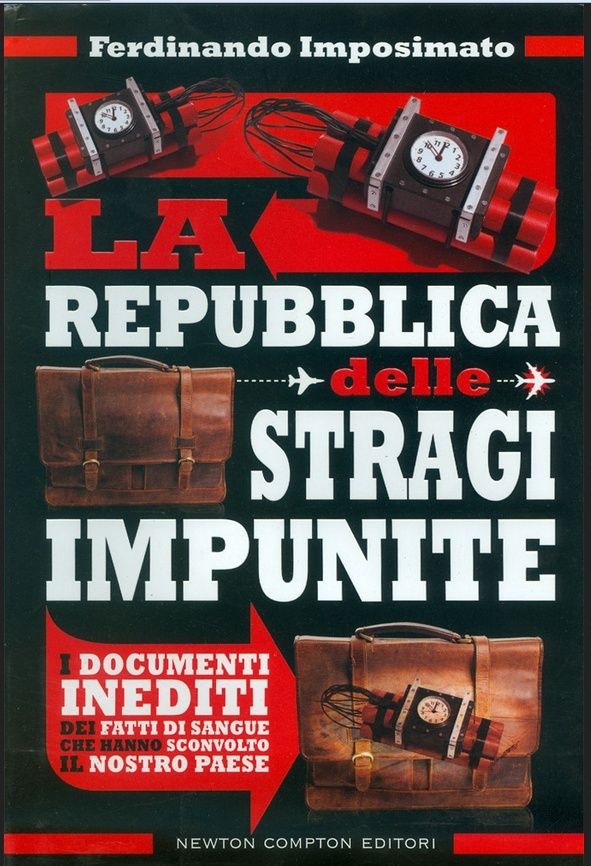 (...) The report deplored the attempt to exclude Vatican liability and the stressed the strange lack of any mention of Opus Dei, which especially in the case of Spain, has an important function in the cloak of subversion, even communist. [00.] Clearly, the attempt to partially exonerate the Vatican and the highest hierarchy of the Catholic Church from liability for the subversive action in the West (my italics, author's note), which was planned and organized from that top and not just the result of personal initiatives. The amazing aspect of this story is that one of the main representatives of the U.S. intelligence in Italy was the Pro Deo, father Felix Morlion of the Dominican University of Rome, 'he seemed to be always at a crossroads of encounters between people from the CIA, prelates and big industrialists. A photograph, by Pecorelli, of the Pro Deo rector Felix Morlion appeared in the "World of Today" along with three U.S. Secret Service agents, and Christian Democrat ministers Giuseppe Spataro Mariano Rumor». (...) |
|   | | HERVE
Nombre de messages : 21559
Date d'inscription : 08/12/2009
 |  Sujet: Re: Morlion, Félix Sujet: Re: Morlion, Félix  Sam 18 Juil 2015 - 14:57 Sam 18 Juil 2015 - 14:57 | |
| Objecttype Affiche Inhoudelijke beschrijving Feestzaal St.-Michiel / Offensief-Meeting / Sprekers: Lode Geysen, P.F. MorlionPlaats Antwerpen Datum 07/12/1935 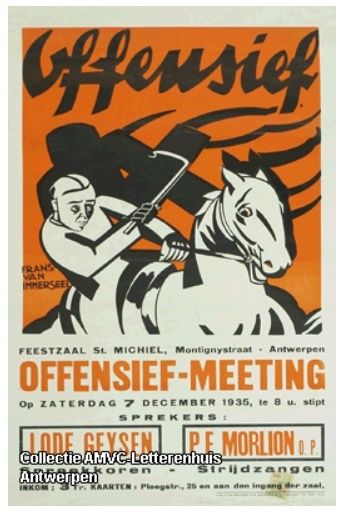 Giulio Andreotti Giulio Andreotti alla presentazione dei corsi della ProDeo a cura di Padre Andrew Felix Morlion. Anno 1948-9. 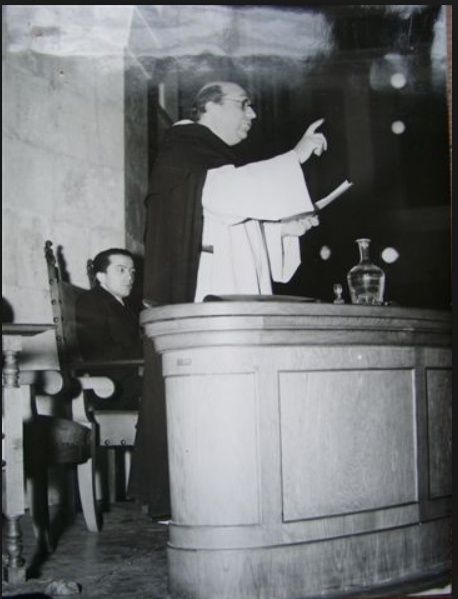 http://www.30giorni.it/articoli_id_2517_l1.htm 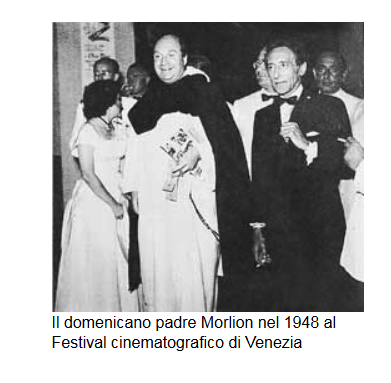 Anno 1968: Il settimanale Mondo d'Oggi pubblica questa foto e annuncia uno scandalo sull' Università Pro Deo   |
|   | | HERVE
Nombre de messages : 21559
Date d'inscription : 08/12/2009
 |  Sujet: Re: Morlion, Félix Sujet: Re: Morlion, Félix  Sam 18 Juil 2015 - 16:19 Sam 18 Juil 2015 - 16:19 | |
|
Un extrait tiré de
https://www.indymedia.org.uk/en/2013/06/510073.html
(...) At the end of World War II, to contain the communist tide the Western victors decided to create an 'alliance between the Catholic the secular liberal forces with a Meeting ground was organized out of which came the NEI (Équipes Nouvelles Internationales), based in Brussels, a sort of Masonic-Catholic Liaison Office with the function of promoting the development of most progressive Christian Democrat forces in the old continent. (...)
Il est question des NEI dans
http://www.cvce.eu/education/unit-content/-/unit/7b137b71-6010-4621-83b4-b0ca06a6b2cb/842f5a49-b878-4a28-9d69-973a795550cd/Resources
http://www.cairn.info/zen.php?ID_ARTICLE=HP_010_00103
Le mouvement était ouvert aux non-catholiques démocrates.
|
|   | | HERVE
Nombre de messages : 21559
Date d'inscription : 08/12/2009
 | |   | | HERVE
Nombre de messages : 21559
Date d'inscription : 08/12/2009
 |  Sujet: Re: Morlion, Félix Sujet: Re: Morlion, Félix  Sam 18 Juil 2015 - 19:45 Sam 18 Juil 2015 - 19:45 | |
| Il est beaucoup question de Felix Morlion dans le livre suivant, disponible en partie sur Google Book : https://books.google.be/books?id=TIqLBQAAQBAJ&pg=PA117&lpg=PA117&dq= morlion,+de+gasperi&source=bl&ots=kX2BzbYe-W&sig=Dvi2EHuxKBGMypBoDQ41LxKnb0E&hl=fr&sa=X&redir_esc=y#v=onepage&q= morlion%2C%20de%20gasperi&f=false : Il faut noter le lien très ancien avec Andreotti ! Quelques extraits... Moralizing Cinema: Film, Catholicism, and Powerpublié par Daniel Biltereyst,Daniela Treveri Gennari 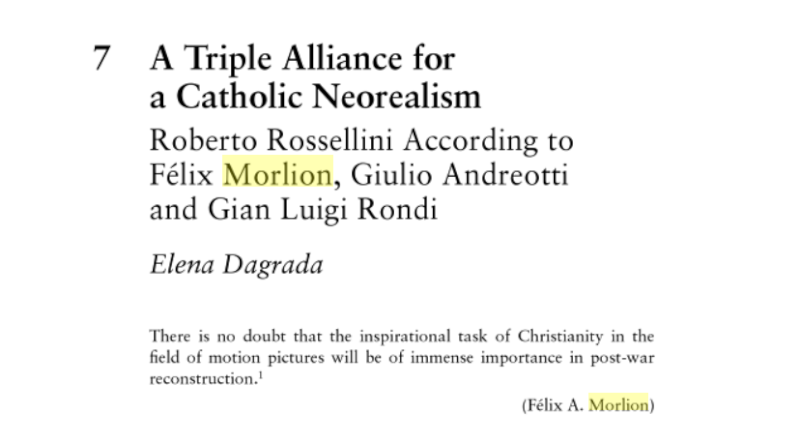 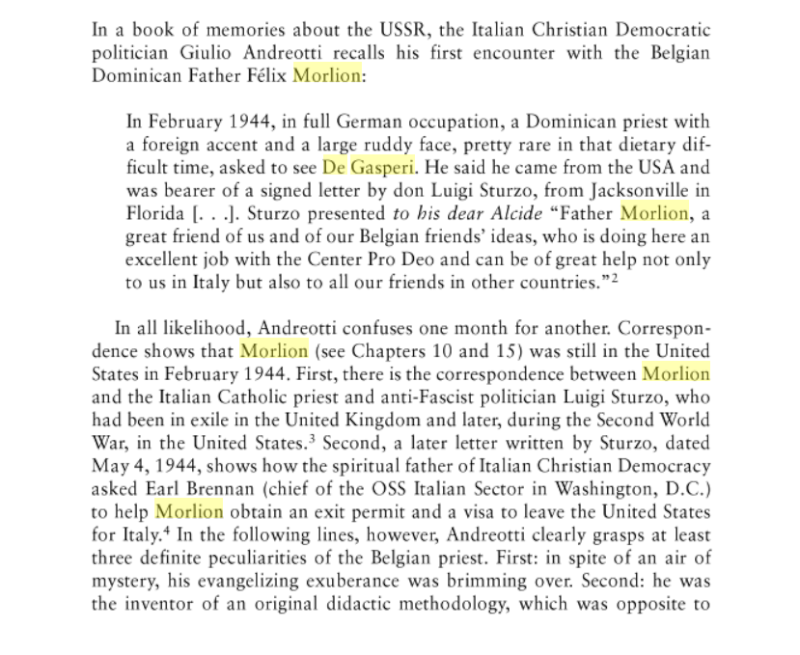  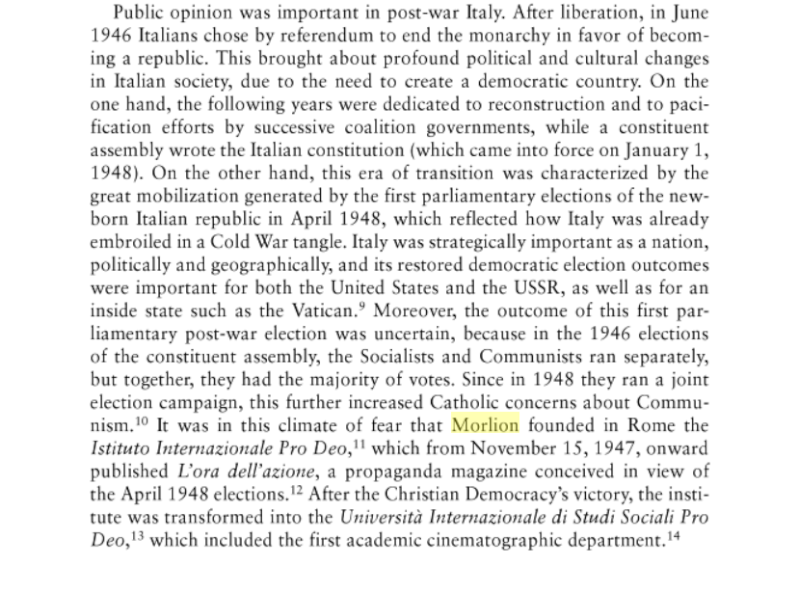   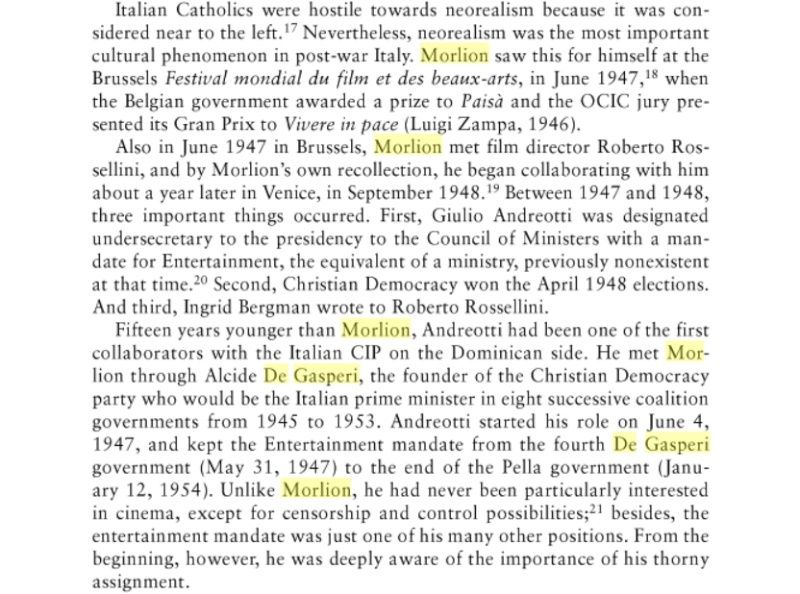 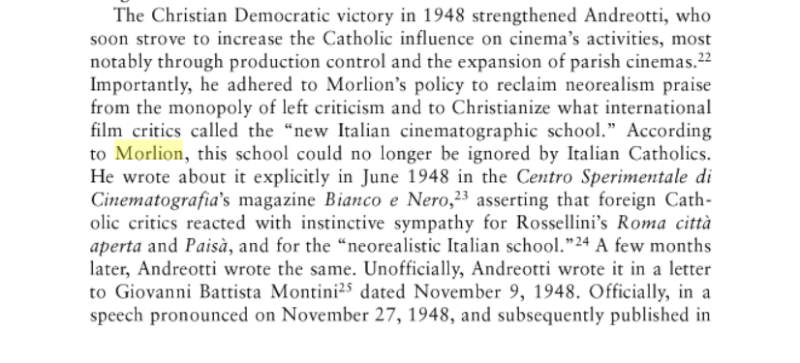 (...) 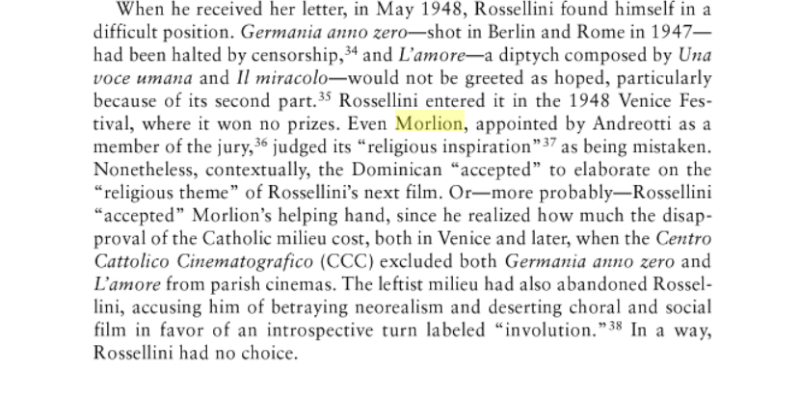 (...)  |
|   | | HERVE
Nombre de messages : 21559
Date d'inscription : 08/12/2009
 |  Sujet: Re: Morlion, Félix Sujet: Re: Morlion, Félix  Sam 18 Juil 2015 - 21:08 Sam 18 Juil 2015 - 21:08 | |
| Andreotti et Scelba ...  Andreotti connaissait bien le père Félix Morlion. Scelba connaissait André Moyen. Cela renforce l'hypothèse de contacts entre Félix Morlion et André Moyen dans le cadre de la lutte anticommuniste ... en lien notamment avec des "services" des USA. |
|   | | HERVE
Nombre de messages : 21559
Date d'inscription : 08/12/2009
 |  Sujet: Re: Morlion, Félix Sujet: Re: Morlion, Félix  Sam 18 Juil 2015 - 21:13 Sam 18 Juil 2015 - 21:13 | |
| La Pira, Andreotti e Scelba al Consiglio Nazionale D.C. 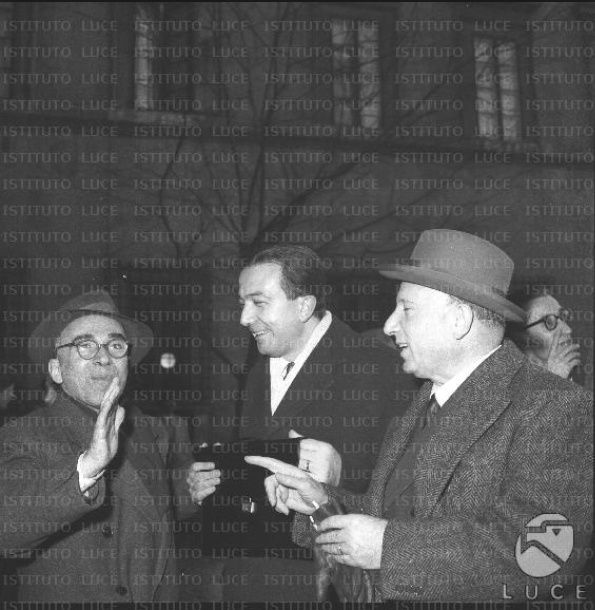 |
|   | | HERVE
Nombre de messages : 21559
Date d'inscription : 08/12/2009
 |  Sujet: Re: Morlion, Félix Sujet: Re: Morlion, Félix  Sam 18 Juil 2015 - 21:21 Sam 18 Juil 2015 - 21:21 | |
|
http://www.storiadc.it/correnti.html
(...) I primi quattro Congressi nazionali della DC (1946, 1947, 1949, 1952) hanno visto i degasperiani guidare saldamente la DC. In larga parte provenivano dall'ex Partito Popolare di don Luigi Sturzo. Tra di essi si distinguono Attilio Piccioni, Giuseppe Spataro, Mario Scelba, Bernardo Mattarella, Giulio Andreotti. (...)
|
|   | | HERVE
Nombre de messages : 21559
Date d'inscription : 08/12/2009
 |  Sujet: Re: Morlion, Félix Sujet: Re: Morlion, Félix  Dim 19 Juil 2015 - 8:46 Dim 19 Juil 2015 - 8:46 | |
|
http://andreacarancini.blogspot.be/2012/01/per-capire-chi-era-don-luigi-sturzo.html
(...) Nel dopoguerra, “un agente dell’Oss fu inviato a Roma per prendere contatto con De Gasperi, Rodinò e Scelba. Fra questi tre leader, l’Oss e Sturzo si creò un sistema triangolare. Uno dei frutti di questa collaborazione fu il finanziamento da parte degli americani della ‘Pro Deo’, un centro affidato a Padre Morlion. (…) una volta stabilito il centro ‘Pro Deo’ Morlion scrisse e raccontò che ad assisterlo con la pubblicità era un giovane mandatogli da De Gasperi, chiamato Giulio Andreotti”. (...)
Traduction Google :
Après la guerre, "un agent de l'OSS a été envoyé à Rome pour prendre contact avec De Gasperi, Rodino et Scelba. Parmi ces trois leaders, l'Oss et monté son créé un système triangulaire. Un des fruits de cette collaboration est le financement par les Américains de la «Pro Deo ', un centre confiée au père Morlion. (...) Une fois qu'il a établi le centre «Pro Deo 'Morlion écrit et vous dit pour aider à la publicité a été envoyé à lui par un jeune De Gasperi, appelé Giulio Andreotti."
|
|   | | HERVE
Nombre de messages : 21559
Date d'inscription : 08/12/2009
 |  Sujet: Re: Morlion, Félix Sujet: Re: Morlion, Félix  Dim 19 Juil 2015 - 8:48 Dim 19 Juil 2015 - 8:48 | |
| FROM ALBANIA TO SICILYPar Adam YAMEY 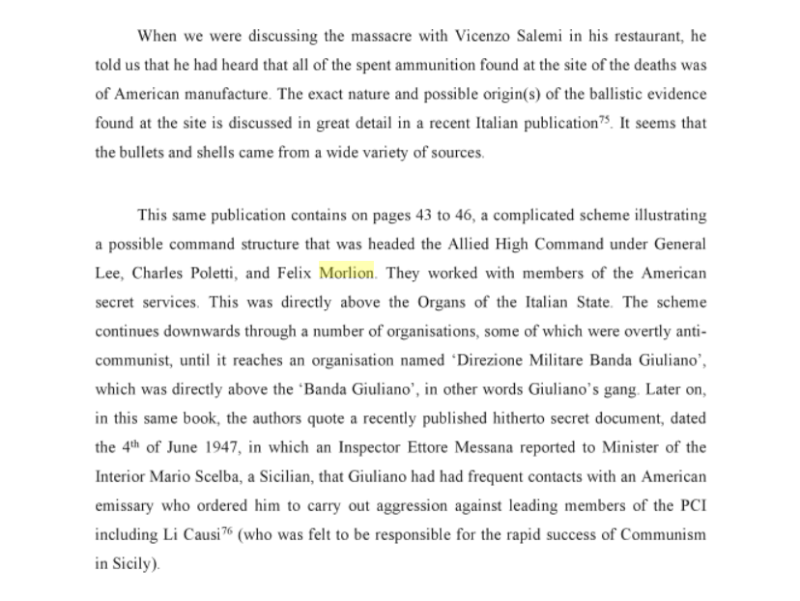 |
|   | | HERVE
Nombre de messages : 21559
Date d'inscription : 08/12/2009
 |  Sujet: Re: Morlion, Félix Sujet: Re: Morlion, Félix  Dim 19 Juil 2015 - 8:50 Dim 19 Juil 2015 - 8:50 | |
|
http://www.ilfattoquotidiano.it/2013/05/06/andreotti-potere-e-misteri1-sponsor-vaticani-portano-giovane-giulio-in-alto/584922/
(...) IL DOMENICANO VENUTO DA WASHINGTON – In Italia tutto sta cambiando. Il fascismo é sconfitto. Gli alleati sono sbarcati nella penisola. Sul finire della guerra l’Oss, l’antenata della Cia, aveva preso a finanziare segretamente, in funzione antifascista e anticomunista, la neonata Dc. Dopo i primi contatti con don Luigi Sturzo, l’ex leader dei popolari, un agente segreto americano aveva aperto un canale anche con De Gasperi. Con i fondi di Washington s’inaugura così a Roma il centro universitario Pro Deo, la cui direzione è affidata a un domenicano. Si chiama padre Felix. A. Morlion. Si devono a lui i rapporti sulla situazione italiana che a partire dal ’44 arrivano a Washington. Morlion é, di fatto, una spia. E come scriverà lui stesso accanto a sé “ad assisterlo nella pubblicità c’é un giovane mandatogli da De Gasperi di nome Giulio Andreotti”. Da quel momento gli americani cominceranno ad inviare fondi allo scudocrociato. Nel corso degli anni, secondo il Congresso Usa, arriveranno in Italia circa 100 milioni di dollari.
Sempre i servizi segreti americani, come é pacificamente documentato dai dispacci dell’Oss, per risolvere la questione del fronte sud e riuscire finalmente a sbarcare in Italia, avevano preso accordi con Cosa Nostra. Nel ‘42 avevano trattano con Lucky Luciano organizzando uno sbarco di agenti prima e di truppe alleate poi nella Sicilia occupata dai nazisti. I primi mafiosi e i primi 007 arriveranno nell’isola nel gennaio e nel febbraio del ‘43. Dopo la liberazione gli amministratori locali legati al vecchio regime saranno sostituiti da uomini d’onore. A guerra finita molti di loro diventeranno democristiani e formeranno la base elettorale dei Dc seguaci di Bernardo Mattarella. La vicenda è fondamentale per comprendere i fenomeni successivi rappresentati da Vito Ciancimino e Salvo Lima (pupillo proprio di Mattarella). (...)
Traduction Google :
LE DOMINICAIN VENU DE WASHINGTON - En Italie, tout est changeant. Le fascisme est vaincu. Les Alliés ont débarqué dans la péninsule. À la fin de la guerre, l'OSS, l'ancêtre de la CIA, avait commencé à financer secrètement, selon l'anti-fasciste et anti-communiste, le Dc naissante. Après le premier contact avec Don Luigi Sturzo, l'ancien chef de la populaire, un agent secret américain avait ouvert un canal avec De Gasperi. Avec des fonds de Washington a été inauguré comme le centre universitaire à Rome Pro Deo, dont la gestion est confiée à un dominicain. Son nom est Père Felix. A. Morlion. Il doit pour lui des rapports sur la situation italienne que de '44 venir à Washington. Morlion est, en fait, un espion. Et comme il écrivit lui-même à côté de lui "pour aider à la publicité il y a un jeune homme envoyé à lui par De Gasperi nommé Giulio Andreotti." A partir de ce moment, les Américains commencent à envoyer des fonds à scudocrociato. Au fil des ans, selon le Congrès des États-Unis, arrivera en Italie environ 100 millions de dollars.
Toujours les services secrets américains, comme cela est documenté par distribue pacifiquement OSS, pour résoudre le problème du sud, et pour finalement atterrir en Italie, avaient pris des arrangements avec la Cosa Nostra. En '42 ils traitent avec Lucky Luciano organiser un agents d'atterrissage d'abord, puis des troupes alliées en Sicile occupés par les nazis. Le premier mafia et la première 007 arriveront dans l'île en Janvier et en Février '43. Après la libération des responsables locaux liés à l'ancien régime seront remplacés par des hommes d'honneur. Après la guerre, beaucoup d'entre eux deviendront des démocrates et formeront la base d'adeptes Dc électorales de Bernardo Mattarella. L'histoire est essentielle à la compréhension des phénomènes suivants représentés par Vito Ciancimino et Salvo Lima (protégé juste Mattarella).
|
|   | | HERVE
Nombre de messages : 21559
Date d'inscription : 08/12/2009
 |  Sujet: Re: Morlion, Félix Sujet: Re: Morlion, Félix  Dim 19 Juil 2015 - 8:57 Dim 19 Juil 2015 - 8:57 | |
|
Il est aussi question de Félix Morlion dans
http://massimodelpapa.blogspot.be/2013/05/andreotti-che-brillava-di-ombre-proprie.html
ANDREOTTI, CHE BRILLAVA DI OMBRE PROPRIE
Massimo Del Papa lunedì, maggio 06, 2013 Libri, Misteri Dolorosi
Traduction Google :
"(...) Mais l'indignation la plus choquante, sur les mystères douloureux Fermo, concerne l'ancien hiérarque SS Carl Hass, chef de la Fosse Ardeatine, qu'en 1946, dans la période d'après-guerre, est situé à Fermo sous le faux couvert d'un professeur d'anglais et de mathématiques au collège local du Sacré-Cœur, qui est accroché par des émissaires du Père Felix Morlion, l'homme de la CIA en Europe, liée aux démocrates-chrétiens comme parrains De Gasperi, Scelba et Andreotti, qui a même secrétaire d'Morlion .. particulier interrogation Unis Hass rendu le 4 Juillet 1996 à le maréchal et le capitaine Ros de Massimo Giraudo Cosimo Pano Il dit Hass (rapporté dans le livre "Les années de déshonneur", Mario Guarino et Fedora Raugei, Daedalus, 2006): " En Novembre 1947, je vivais dans la clandestinité dans le monastère, peut-être le Sacré-Cœur, à Fermo, où je vivais par le professeur d'anglais et de mathématiques [...]. Dans la pratique, je faisais partie d'un réseau de nombreux agents qui opérait sous la responsabilité de Morlion père. Je avvalevo ou mieux recepivo les informations se référant aux Américains dans les environnements MSI, notamment par Mario Tedeschi et Giorgio Almirante par son bureau de presse. Je signale que les Allemands était un agent de la CIC (le contre-espionnage américain, note de l'auteur), le fait que je appris au cours d'une dispute qu'ils avaient avec Almirante sur la destination des fonds américains atteint MSI ". La parabole du Hass, qui semble à première absurde, vice-versa est absolument conforme à la logique, utilitaire et trempé dans la realpolitik, le dépassement de la Seconde Guerre mondiale, en particulier en Italie. Déjà actif pendant le conflit à Vérone, avec la tâche d'espionnage pour l'Allemagne nazie, qui est un exposant influent, Hass après la guerre a réussi à entrer dans le réseau d'information américaine: donner la gestion des contacts entre les services et les Etats-Unis cercles romains de l'extrême droite. Mais Hass est également impliqué dans le contrôle de la relation entre les communistes italiens et allemands. "Une fois de retour dans leur patrie," il lit la "Terreur dans le Nord" précitée, l'ancien officier nazi continue de travailler avec le Service d'information militaire, et en particulier la préparation de nouveaux agents des services fédéraux de l'Allemagne. Et à cette époque, il commence à se former [en Italie] Organisation de la sécurité des forces armées dans la fonction anti-; une structure qui fait plusieurs peep dans la première enquête sur les années soixante-dix sur «massacres noir». Tout, comme vous le voyez, il a laissé Fermo, la ville que dans ces mêmes années donne naissance à l'avenir la tête RB Mario Moretti ...
*
Alors que Hass tisser sa toile, une Licio Gelli fin de la vingtaine, mais déjà plein d'aventures mystérieuses par encore trouble, essuyant la fois le passé républicain-fasciste à la fois par les activités parallèles controinformatore partisane. Alors que, dans la province de Fermo nell'appartata, Hass, est inséré dans le réseau d'espionnage américain, Gelli, en aucun provinces moins fermés d'Arezzo et de Pistoia, peut prendre, à partir de peuplement robivecchi de son père, son incroyable ascension au pouvoir jusqu'à sa italienne sommets, ses secrets, ses mystères irriferibili.
Comme pour le Père Felix Morlion, entre l'Italie en 1944 par l'OSS américain, pour lequel déjà en 1932 avait fondé le CIP, les centres d'information pro deo; la filiale italienne de la CIP est contextuelle et déploie élite de commanditaires nationaux tels que le chrétien-démocrates De Gasperi, Scelba, Andreotti, qui est encore secrétaire Morlion. Parmi le premier à mentionner le prélat-espion ambiguë, l'habituel Pecorelli qu'en 1968 mit fin à la parabole du journalisme «Nouveau Monde aujourd'hui" révélateur de la «Pro-Deo comme une couverture pour un centre d'espionnage du Service de sécurité de minstero Intérieur (dirigé par le chef Elvio Catenacci et vice U. Federico D'Amato, alors à la tête des affaires privées puissantes), et son directeur, «le père de l'agent de la CIA Morlion". Les rumeurs selon lesquelles ils trouveront confirmations en temps opportun ans plus tard, lorsque les archives de Uruguayens Gelli pousse un transfert de fichier à Morlion (cfr. "Dossier Pecorelli", édité par S. Flamigni, Kaos, 2005). Parmi les clients de l'un des fondateurs de prototerroristico "superclan" Corrado Simioni, à la fois dans les relations avec Moretti avec les services, leur figure paternelle Felix Morion, dont les coordonnées, comme mentionné, sera trouvé dans le matériel saisi aux brigades et Adriana Valerio Morucci Faranda , deux des lieutenants les plus influents Mario Moretti, simultanément à leur arrestation le 29 mai 1979 dans la maison de Giuliana Outline collègue Franco Piperno, dans le halo d'autonomie. (...) "
(De "Mystères Douloureux - Histoires de terrorisme dans le italien d'après-guerre», ebook, 2012, via Smashwords, Amazon, iTunes ...)
Moro, pris en otage par les Brigades rouges dans la «prison du peuple», va passer dans ses mémoires derniers mots de mépris, que pour quelqu'un d'autre, à Andreotti, remettant en question par une série de circonstances que les Brigades rouges, de façon surprenante, en choisissant de ne pas divulguer . Tout d'abord, mais pas tout seul, entre tous, l'existence de l'organisme de sécurité Gladio. Moro, qui en 1973 avait appelé le lobbyiste mafieux Michele Sindona «sauveur de la lire», fut longtemps protecteur de l'autre piduista de fixateur, Licio Gelli, le même âge, il est toujours vivant. Certaines pages qui impliquent Andreotti semblent effacées à partir des copies de la Moro mémoire (l'original n'a jamais été retrouvé).
|
|   | | HERVE
Nombre de messages : 21559
Date d'inscription : 08/12/2009
 |  Sujet: Re: Morlion, Félix Sujet: Re: Morlion, Félix  Dim 19 Juil 2015 - 9:04 Dim 19 Juil 2015 - 9:04 | |
|
http://www.fondazionesnc.org/news/venezia_14.asp
(...) (Giulio Andreotti, Mario Scelba e Felix Morlion ndr) (...)
http://www.lavocedinewyork.com/Segreti-di-Stato-cinema-o-storia/d/215/
|
|   | | HERVE
Nombre de messages : 21559
Date d'inscription : 08/12/2009
 |  Sujet: Re: Morlion, Félix Sujet: Re: Morlion, Félix  Dim 19 Juil 2015 - 9:12 Dim 19 Juil 2015 - 9:12 | |
| Malpaese: criminalità, corruzione e politica nell'Italia della prima ...Par Alessandro Silj 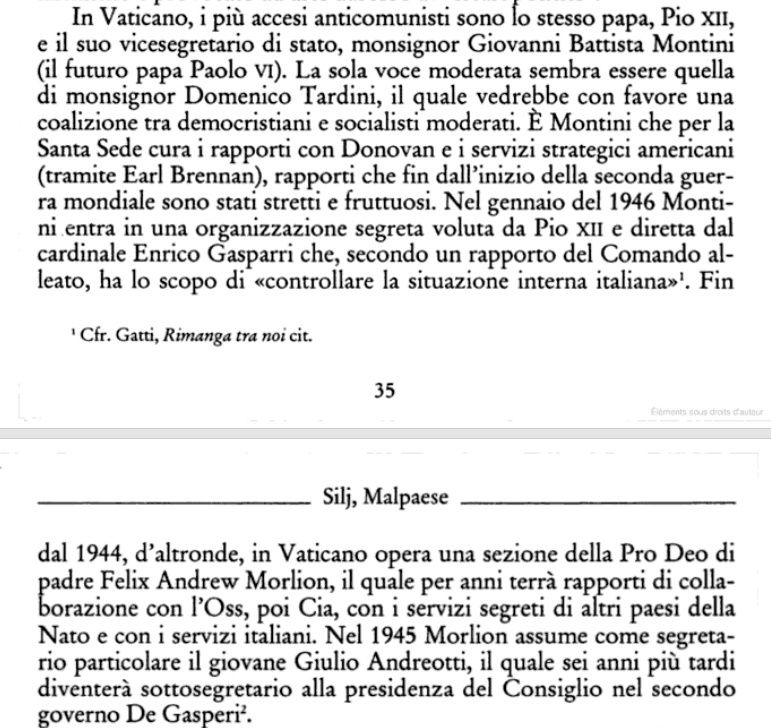 |
|   | | HERVE
Nombre de messages : 21559
Date d'inscription : 08/12/2009
 |  Sujet: Re: Morlion, Félix Sujet: Re: Morlion, Félix  Dim 19 Juil 2015 - 9:27 Dim 19 Juil 2015 - 9:27 | |
|
Plusieurs longs articles (en italien)
https://escogitur.wordpress.com/2013/03/05/padre-felix-morlion-un-domenicano-tutto-da-conoscere-anzi-meglio-da-evitare-il-fondatore-dei-servizi-segreti-europei/
Cela détaille notamment la biographie de Félix Morlion.
Extrait (traduit) :
Dans "Bulletin d'information de l'action secrète", publication fondée par l'ancien agent de la CIA Philip Agee, disponible dans divers sites Web, il ya des références qui relient Morlion à l'Ordre Souverain Militaire de Malte (SMOM), en matière de financement et d'honneurs conférés avant la guerre à des cercles pro-nazis, et après la guerre de Nazi "recyclé" comme Reinhard Gehlen, services de passé nazi aux services avant les Etats-Unis et de l'Allemagne occidentale alors. Enfin, Morlion figure parmi les fondateurs du Centre pour la justice économique et sociale (CESJ) dont plusieurs hauts prélats, membres de personnalités de la finance et divers internationales, ayant des idées conservatrices communs et être favorable au marché libre.
Père Morlion, serviteur discret de 5 papes et active dans de nombreux domaines ne sont pas toujours les clercs, est mort en 1987. Il avait une part active, comme nous l'avons vu, dans une grande partie de l'histoire de la République italienne, mais il lui manque une biographie qui met en évidence un caractère si importante.
|
|   | | HERVE
Nombre de messages : 21559
Date d'inscription : 08/12/2009
 | |   | | HERVE
Nombre de messages : 21559
Date d'inscription : 08/12/2009
 |  Sujet: Re: Morlion, Félix Sujet: Re: Morlion, Félix  Dim 19 Juil 2015 - 10:37 Dim 19 Juil 2015 - 10:37 | |
| André Moyen a écrit dans l'hebdomadaire "Septembre". Le journal accueille des valeurs sûres de la droite, comme le vicomte Charles Terlinden et le baron Pierre Nothomb, des personnalités connues pour avoir flirté avec le fascisme avant-guerre. Par ailleurs : BTNG, Volume 18 SOMA-CEGES., 1987  De netwerking van een neo-aristocratische elite De netwerking van een neo-aristocratische elite Klaartje Schrijvers https://biblio.ugent.be/input/download?func=downloadFile&recordOId=4175616&fileOId=4175676 (...) COPAC fungeerde vermoedelijk als fondsenwerver voor de SEPES en werd voorgezeten door bruggraaf Charles Terlinden, Jean Spiltoir, en pater Morlion. Het is interessant erop te wijzen dat in mei 1938 een Belgische delegatie bestaande uit De Roover, Greindl, Spiltoir, Terlinden, Stappaerts, pater Morlion en kardinaal Van Roey deelnam aan een congres van de Entente Internationale Anti-Communiste te Genève. (...) Een vierde organisatie werd Concentration de la Propagande anti-communiste (COPAC) gedoopt. Een exacte oprichtingsdatum is niet geweten. Vast staat dat op 2 juni 1937 ten huize van Charles Terlinden een reünie plaatsvond waarop diverse grote industriëlen en rabiate anti-marxisten waren uitgenodigd. Heel wat leden van SEPES waren aanwezig en in 1938 was officieel sprake van COPAC. Genodigden waren ondermeer baron Paul de Launoit van Ougrée-Marihaye, Greiner van Cockerill, voormalig eerste minister Georges Theunis, burggraaf Simonis, advocaat Duvieusart, Max-Léo Gérard, baron Léon Greindl en ook Marcel De Roover. COPAC fungeerde vermoedelijk als fondsenwerver voor de SEPES en werd voorgezeten door bruggraaf Charles Terlinden, Jean Spiltoir, en pater Morlion. Het is interessant erop te wijzen dat in mei 1938 een Belgische delegatie bestaande uit De Roover, Greindl, Spiltoir, Terlinden, Stappaerts, pater Morlion en kardinaal Van Roey deelnam aan een congres van de Entente Internationale Anti-Communiste te Genève. We zullen meteen zien dat die Entente Internationale ons naar het hartje van SEPES leidt _ _ _ Il semble de plus en plus probable que André Moyen et Félix Morlion se sont connus. Anvers a joué un rôle important pour eux deux (BACB, De Waarheid, etc). Ils avaient des liens avec les "services" des USA. Félix Morlion (1904-1987) a rencontré Giulio Andreotti (1919-2013) en 1944... |
|   | | HERVE
Nombre de messages : 21559
Date d'inscription : 08/12/2009
 |  Sujet: Re: Morlion, Félix Sujet: Re: Morlion, Félix  Dim 19 Juil 2015 - 14:18 Dim 19 Juil 2015 - 14:18 | |
|
Un article de fond sur Pro Deo :
http://www.cairn.info/zen.php?ID_ARTICLE=RFEA_107_46
« A Philosophy of Democracy under God » : C.D. Jackson, Henry Luce et le mouvement Pro Deo (1941-1964)
Publié dans
Revue française d’études américaines
2006/1 (no 107)
Développé en Europe avant la Seconde Guerre mondiale par des personnalités catholiques, puis aux États-Unis pendant la guerre, le mouvement Pro Deo (« Pour Dieu ») reçut du côté américain le soutien de Henry Luce, l’influent patron de Time-Life, Inc., et de C.D. Jackson, correspondant de Luce pour ce dossier auprès des Européens, y compris lorsque celui-ci est nommé conseiller pour la guerre froide du président Eisenhower, et l’épouse de Luce ambassadeur des États-Unis à Rome. À l’intersection des milieux du renseignement, de la diplomatie culturelle, des médias et de la politique extérieure, le mouvement Pro Deo va dans le sens des initiatives de lutte contre le communisme alors soutenues par l’administration américaine en Europe. À travers Henry Luce et C.D. Jackson, l’analyse des soutiens américains à Pro Deo permet de se pencher sur l’élément religieux qui façonne la vision du monde d’une certaine élite américaine, sur le rôle de la religion dans la guerre froide et sur les réseaux religieux comme outil d’influence renforçant la politique extérieure des États-Unis.
(...)
De son côté, C.D. Jackson s’impose à partir des années 1940 comme une personnalité fascinante, au croisement du monde des médias, du renseignement et de la politique. Proche collaborateur de Luce depuis 1931, vice-président de Time, Inc., Jackson est un apôtre de la guerre psychologique, qu’il a pratiquée avec succès pendant la guerre auprès du général Eisenhower, comme directeur adjoint de la section de guerre psychologique des troupes alliées, d’abord en Afrique du Nord en 1943, puis à Londres en 1944-45. Il noue à cette occasion des contacts étroits avec l’OSS et Allen Dulles. Après la guerre, il passe, sans discontinuité à ses yeux, du développement de l’édition internationale de Time et Life et de la direction éditoriale de Fortune au soutien, puis à la présidence en 1951, du National Committee for a Free Europe (NCFE), groupe privé soutenu par la CIA qui organise une propagande active envers l’Europe centrale et orientale et dont l’élément le plus connu est Radio Free Europe (RFE). Expert de l’écrit et des médias, apprécié d’Eisenhower, pour qui il rédige des discours, il devient assistant spécial auprès du président pour les affaires internationales en 1953-1954, trouvant ainsi une place privilégiée pour proposer ses idées parfois audacieuses mêlant propagande, diplomatie culturelle et action psychologique (Brands 117-137, Cook).
(...)
Note : il est tentant de penser au major Jean Bougerol, de la Milice de Jésus-Christ (dominicaine), lui aussi passionné de guerre psychologique...
|
|   | | HERVE
Nombre de messages : 21559
Date d'inscription : 08/12/2009
 |  Sujet: Re: Morlion, Félix Sujet: Re: Morlion, Félix  Dim 19 Juil 2015 - 15:08 Dim 19 Juil 2015 - 15:08 | |
| Félix Morlion a joué un rôle dans les "Dartmouth Conferences" ; il a même rencontré David Rockefeller... https://en.wikipedia.org/wiki/Dartmouth_Conferences_%28peace%29 On peut le lire dans Dialogue Sustained: The Multilevel Peace Process and the Dartmouth ConferencePar James Voorhees 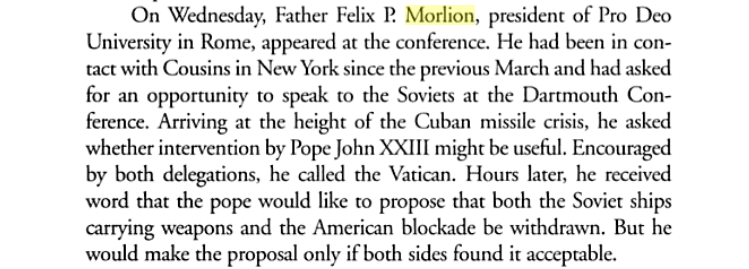 (...) 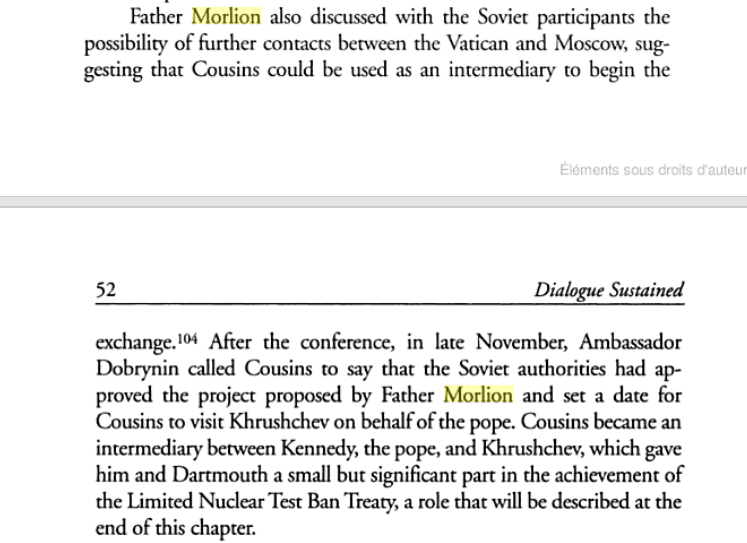 (...) 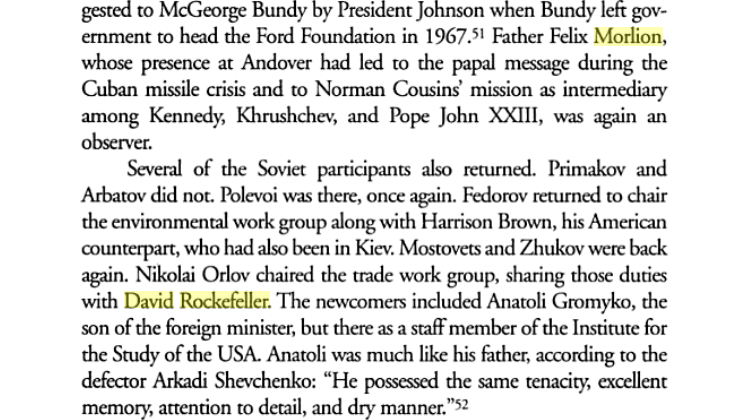 |
|   | | HERVE
Nombre de messages : 21559
Date d'inscription : 08/12/2009
 |  Sujet: Re: Morlion, Félix Sujet: Re: Morlion, Félix  Dim 19 Juil 2015 - 15:22 Dim 19 Juil 2015 - 15:22 | |
| Dans les archives : http://www.eisenhower.archives.gov/research/subject_guides/pdf/Propaganda_Psychological_Warfare.pdf  |
|   | | HERVE
Nombre de messages : 21559
Date d'inscription : 08/12/2009
 |  Sujet: Re: Morlion, Félix Sujet: Re: Morlion, Félix  Dim 19 Juil 2015 - 16:47 Dim 19 Juil 2015 - 16:47 | |
| Des archives accessibles (12 documents) : http://www.ajcarchives.org/ajcarchive/DigitalArchive.aspx Par exemple : http://www.ajcarchives.org/AJC_DATA/Files/688.PDF 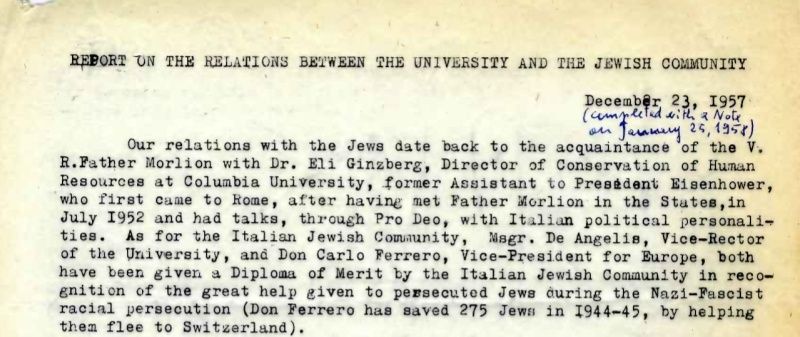 (...) _ _ _  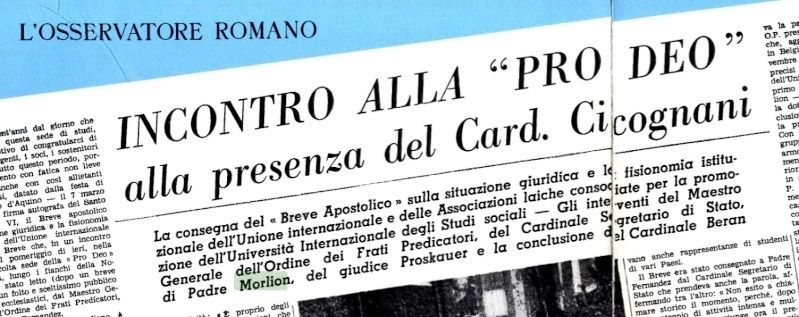 _ _ _ 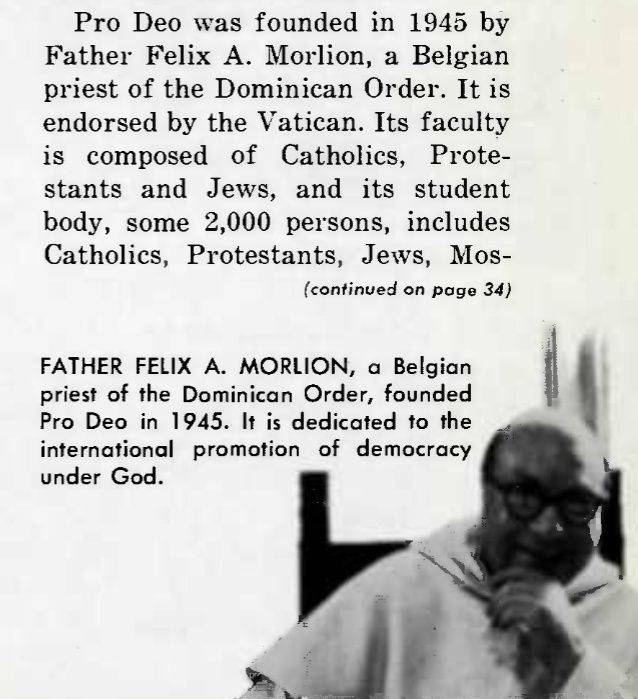 _ _ _ 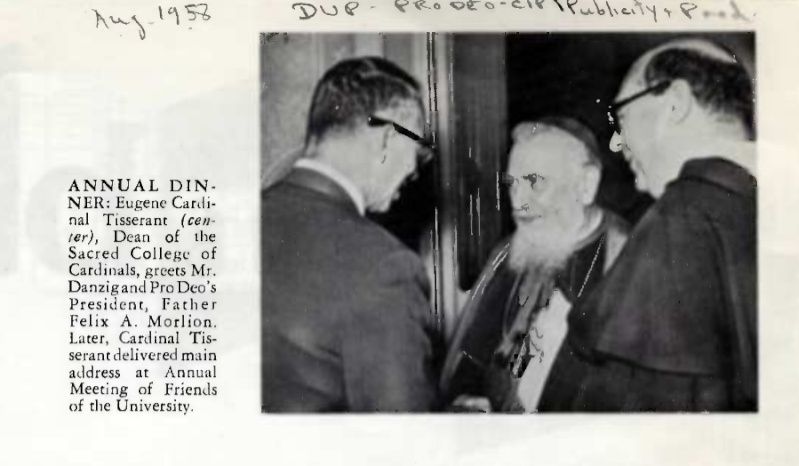 |
|   | | HERVE
Nombre de messages : 21559
Date d'inscription : 08/12/2009
 |  Sujet: Re: Morlion, Félix Sujet: Re: Morlion, Félix  Dim 19 Juil 2015 - 17:43 Dim 19 Juil 2015 - 17:43 | |
| http://www.luiss.edu/news/2014/11/03/public-and-private-diplomatic-career Alessandro Cagli, director of European Affairs for Ferrero in Brussels, who has a lot of experience in EU politics, was one of LUISS's first graduatesAlessandro Cagli is not only the director of European Affairs for Ferrero in Brussels, but was also one of the first graduates in Political Science in LUISS’s history. 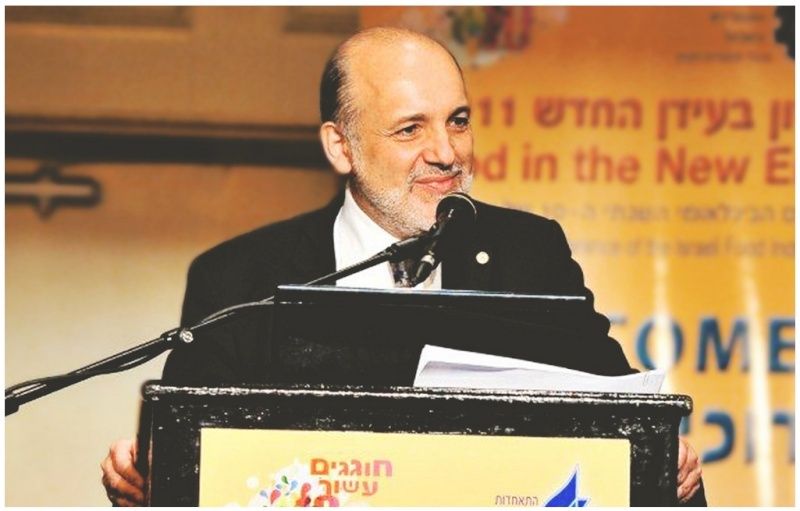 "I started at LUISS when the university was first established, during the years when Confindustria had taken over Pro Deo. It was a period when the university was seeking a new identity: a phase of creative chaos that was really stimulating, with professors from various universities who came and went. At the same time, there were a number of great figures such as Paolo Savona, former minister and professor of Economic and Financial Policy, who stayed at LUISS and helped build its reputation. The confirmation of this is my degree from 1979, which has the ‘historic’ signature of the then-provost Rosario Romeo and the administrative director Giovanni Nocco." Before becoming part of the well-known Italian group and serving on the board of directors of the Association of LUISS graduates in Brussels, Cagli began his career at the Banca Commerciale Italiana. "At the time it was common for companies to look for graduates with high grades, rather than the opposite. I had just finished university and I had not yet decided what to do: with a degree in Political Science you could do a lot of different things. I was given this opportunity and decided to run with it." (...) |
|   | | HERVE
Nombre de messages : 21559
Date d'inscription : 08/12/2009
 |  Sujet: Re: Morlion, Félix Sujet: Re: Morlion, Félix  Dim 19 Juil 2015 - 17:53 Dim 19 Juil 2015 - 17:53 | |
|
Félix Morlion avait une correspondance avec Paul-Henri Spaak ...
https://repository.library.georgetown.edu/bitstream/handle/10822/559110/GTM.GAMMS330.html?sequence=1&isAllowed=y#ref415
|
|   | | HERVE
Nombre de messages : 21559
Date d'inscription : 08/12/2009
 |  Sujet: Re: Morlion, Félix Sujet: Re: Morlion, Félix  Dim 19 Juil 2015 - 18:09 Dim 19 Juil 2015 - 18:09 | |
| |
|   | | Contenu sponsorisé
 |  Sujet: Re: Morlion, Félix Sujet: Re: Morlion, Félix  | |
| |
|   | | | | Morlion, Félix |  |
|
| | Permission de ce forum: | Vous ne pouvez pas répondre aux sujets dans ce forum
| |
| |
| |
